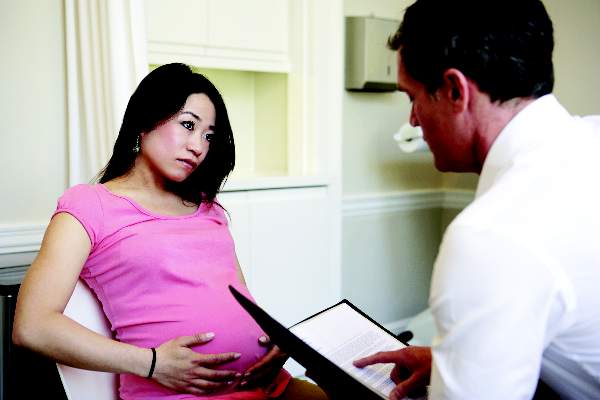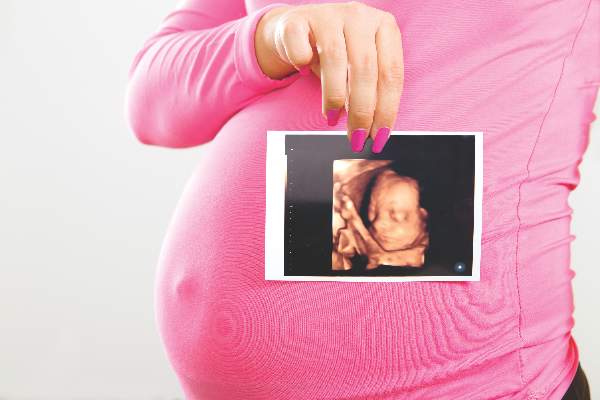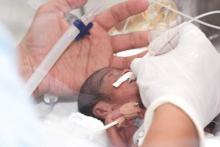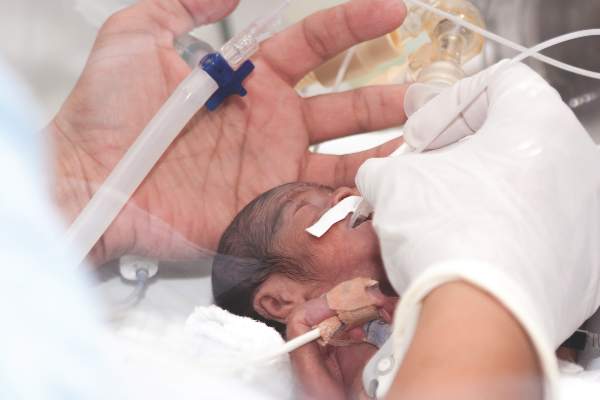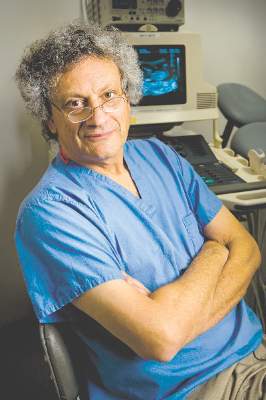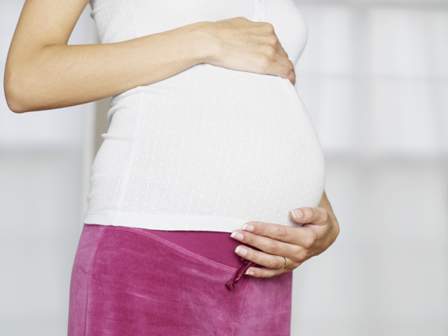User login
Pessary for short cervix doesn’t prevent preterm delivery
Placement of a pessary to support a short cervix failed to prevent preterm delivery, compared with expectant management, in an international open-label trial reported online March 16 in the New England Journal of Medicine.
Transvaginal placement of a silicone pessary around the cervix “is thought to support the cervix and change its direction toward the sacrum, thereby reducing the direct pressure from the uterine contents on the cervical canal.” However, two recent randomized trials of this treatment produced contradictory results, with one showing the device reducing the rate of spontaneous preterm delivery and the other showing it had no effect, reported Dr. Kypros H. Nicolaides of the Harris Birthright Research Center for Fetal Medicine, King’s College, London, and his colleagues.
They performed a randomized trial of women aged 16 years and older who had singleton pregnancies and who were found at routine ultrasound examination at 20-24 weeks’ gestation to have a cervical length of 25 mm or less. These study participants – enrolled during a 5-year period at 16 maternity hospitals in England, Slovenia, Portugal, Chile, Australia, Italy, Albania, Germany, and Belgium – were assigned to either placement of a cervical pessary or expectant management and followed every 4 weeks until delivery. The analysis included 465 women in the pessary group and 467 women in the control group.
Women who had a very short cervix (15 mm or less) were also given intravaginal progesterone capsules to use nightly.
The primary outcome measure – spontaneous delivery before 34 weeks’ gestation – occurred in 55 women (12.0%) who received pessaries and 50 (10.8%) in the control group. This outcome remained similar between the two study groups when the data were adjusted to control for treatment center and for the patients’ cervical length, obstetric history, progesterone use, and antibiotic treatment.
Secondary outcomes of perinatal death, adverse neonatal events, and need for special neonatal care also did not differ significantly between women who received a pessary and those who did not, the researchers reported (N Engl J Med. 2016;374:1044-52). Both the primary and secondary outcomes were unchanged in a series of post-hoc subgroup analyses.
Women who received a pessary reported higher rates of new or increased vaginal discharge (46.8% vs. 13.8%) and pelvic discomfort (11.4% vs. 3.4%) during follow-up visits. Pessaries were removed before 34 weeks’ in 114 women (24.5%), usually due to iatrogenic delivery, preterm labor, or premature rupture of the membranes. But 47 women requested pessary removal because of discomfort, vaginal discharge, or vaginal bleeding.
This study was supported by the Fetal Medicine Foundation. Dr. Nicolaides and his colleagues reported having no relevant financial disclosures.
Placement of a pessary to support a short cervix failed to prevent preterm delivery, compared with expectant management, in an international open-label trial reported online March 16 in the New England Journal of Medicine.
Transvaginal placement of a silicone pessary around the cervix “is thought to support the cervix and change its direction toward the sacrum, thereby reducing the direct pressure from the uterine contents on the cervical canal.” However, two recent randomized trials of this treatment produced contradictory results, with one showing the device reducing the rate of spontaneous preterm delivery and the other showing it had no effect, reported Dr. Kypros H. Nicolaides of the Harris Birthright Research Center for Fetal Medicine, King’s College, London, and his colleagues.
They performed a randomized trial of women aged 16 years and older who had singleton pregnancies and who were found at routine ultrasound examination at 20-24 weeks’ gestation to have a cervical length of 25 mm or less. These study participants – enrolled during a 5-year period at 16 maternity hospitals in England, Slovenia, Portugal, Chile, Australia, Italy, Albania, Germany, and Belgium – were assigned to either placement of a cervical pessary or expectant management and followed every 4 weeks until delivery. The analysis included 465 women in the pessary group and 467 women in the control group.
Women who had a very short cervix (15 mm or less) were also given intravaginal progesterone capsules to use nightly.
The primary outcome measure – spontaneous delivery before 34 weeks’ gestation – occurred in 55 women (12.0%) who received pessaries and 50 (10.8%) in the control group. This outcome remained similar between the two study groups when the data were adjusted to control for treatment center and for the patients’ cervical length, obstetric history, progesterone use, and antibiotic treatment.
Secondary outcomes of perinatal death, adverse neonatal events, and need for special neonatal care also did not differ significantly between women who received a pessary and those who did not, the researchers reported (N Engl J Med. 2016;374:1044-52). Both the primary and secondary outcomes were unchanged in a series of post-hoc subgroup analyses.
Women who received a pessary reported higher rates of new or increased vaginal discharge (46.8% vs. 13.8%) and pelvic discomfort (11.4% vs. 3.4%) during follow-up visits. Pessaries were removed before 34 weeks’ in 114 women (24.5%), usually due to iatrogenic delivery, preterm labor, or premature rupture of the membranes. But 47 women requested pessary removal because of discomfort, vaginal discharge, or vaginal bleeding.
This study was supported by the Fetal Medicine Foundation. Dr. Nicolaides and his colleagues reported having no relevant financial disclosures.
Placement of a pessary to support a short cervix failed to prevent preterm delivery, compared with expectant management, in an international open-label trial reported online March 16 in the New England Journal of Medicine.
Transvaginal placement of a silicone pessary around the cervix “is thought to support the cervix and change its direction toward the sacrum, thereby reducing the direct pressure from the uterine contents on the cervical canal.” However, two recent randomized trials of this treatment produced contradictory results, with one showing the device reducing the rate of spontaneous preterm delivery and the other showing it had no effect, reported Dr. Kypros H. Nicolaides of the Harris Birthright Research Center for Fetal Medicine, King’s College, London, and his colleagues.
They performed a randomized trial of women aged 16 years and older who had singleton pregnancies and who were found at routine ultrasound examination at 20-24 weeks’ gestation to have a cervical length of 25 mm or less. These study participants – enrolled during a 5-year period at 16 maternity hospitals in England, Slovenia, Portugal, Chile, Australia, Italy, Albania, Germany, and Belgium – were assigned to either placement of a cervical pessary or expectant management and followed every 4 weeks until delivery. The analysis included 465 women in the pessary group and 467 women in the control group.
Women who had a very short cervix (15 mm or less) were also given intravaginal progesterone capsules to use nightly.
The primary outcome measure – spontaneous delivery before 34 weeks’ gestation – occurred in 55 women (12.0%) who received pessaries and 50 (10.8%) in the control group. This outcome remained similar between the two study groups when the data were adjusted to control for treatment center and for the patients’ cervical length, obstetric history, progesterone use, and antibiotic treatment.
Secondary outcomes of perinatal death, adverse neonatal events, and need for special neonatal care also did not differ significantly between women who received a pessary and those who did not, the researchers reported (N Engl J Med. 2016;374:1044-52). Both the primary and secondary outcomes were unchanged in a series of post-hoc subgroup analyses.
Women who received a pessary reported higher rates of new or increased vaginal discharge (46.8% vs. 13.8%) and pelvic discomfort (11.4% vs. 3.4%) during follow-up visits. Pessaries were removed before 34 weeks’ in 114 women (24.5%), usually due to iatrogenic delivery, preterm labor, or premature rupture of the membranes. But 47 women requested pessary removal because of discomfort, vaginal discharge, or vaginal bleeding.
This study was supported by the Fetal Medicine Foundation. Dr. Nicolaides and his colleagues reported having no relevant financial disclosures.
FROM THE NEW ENGLAND JOURNAL OF MEDICINE
Key clinical point: A pessary placed to support a short cervix failed to prevent preterm delivery, compared with expectant management.
Major finding: The primary outcome measure – spontaneous delivery before 34 weeks’ gestation – occurred in 12.0% of women who received pessaries and 10.8% who did not, a nonsignificant difference.
Data source: An international, open-label, randomized, controlled trial involving more than 900 pregnant women treated during a 5-year period.
Disclosures: This study was supported by the Fetal Medicine Foundation. Dr. Nicolaides and his colleagues reported having no relevant financial disclosures.
ACOG releases new Choosing Wisely list
Prenatal ultrasounds for nonmedical purposes and routine use of robotic assisted laparoscopic surgery for benign gynecologic disease are among the interventions physicians and patients should question, according to the American College of Obstetricians and Gynecologists.
The organization produced the list of five interventions to be questioned as part of the ABIM (American Board of Internal Medicine) Foundation’s Choosing Wisely initiative, which “aims to promote conversations between clinicians and patients by helping patients choose care that is supported by evidence, not duplicative of other tests or procedures already received, free from harm, and truly necessary,” according to the Choosing Wisely website.
ACOG released its first Choosing Wisely list in 2003, advising clinicians to avoid elective labor inductions before 39 weeks as well as annual pap tests in women aged 30-65.
“These are good topics to bring up in discussion with patients,” said Dr. Gerardo Bustillo, an ob.gyn. at Orange Coast Memorial Medical Center in Fountain Valley, Calif. “Patients may ask for inappropriate interventions such as early induction of labor, and these recommendations will equip physicians and other healthcare providers in explaining the dangers of certain interventions.”
The five new items include:
1. Avoid using robotic assisted laparoscopic surgery for benign gynecologic disease when it is feasible to use a conventional laparoscopic or vaginal approach.
ACOG states that comparable perioperative outcomes, intraoperative complications, length of hospital stay, and rate of conversion to open surgery result from both robotic-assisted and conventional laparoscopic surgeries but that robotic-assisted techniques cost more and can take longer. But Dr. Bustillo questioned this item’s addition to the list in light of new evidence that “robotic-assisted hysterectomies resulted in fewer postoperative complications than conventional laparoscopic and vaginal hysterectomies, when performed by high-volume robotic gynecologic surgeons,” he said.
The patients undergoing robotic-assisted hysterectomy, he added, experienced the same or decreased intraoperative and postoperative complications compared with those undergoing conventional techniques despite being more complex patients. They were older with higher rates of adhesive disease, large uteri, and morbid obesity.
2. Don’t perform prenatal ultrasounds for nonmedical purposes, for example, solely to create keepsake videos or photographs.
Keepsake imaging is not an approved use of a medical device by the Food and Drug Administration and is also discouraged by the American Institute of Ultrasound in Medicine. These “comfort ultrasounds” are often performed by the request of the patient and are done without true medical indications,” said Dr. Sherry Ross, an ob.gyn. at Providence Saint John’s Health Center in Santa Monica, Calif.
“Not only are these types of ultrasounds excessive, but they are costly as well,” she said. “Counseling the pregnant woman is the best way to reduce unnecessary ultrasounds, especially those performed at the local mall.”
3. Don’t routinely transfuse stable, asymptomatic hospitalized patients with a hemoglobin level greater than 7-8 grams.
“Arbitrary hemoglobin or hematocrit thresholds should not be used as the only criterion for transfusions of packed red blood cells,” ACOG advises. The potential risks of transfusion make this item the most important of the additions, according to Dr. Bustillo. “These risks include infection with certain pathogens, allergic and immune transfusion reactions, volume overload, hyperkalemia, and iron overload,” he said.
4. Don’t perform pelvic ultrasound in average risk women to screen for ovarian cancer.
With an age-adjusted incidence of just 13 ovarian cancer cases per 100,000 women annually, the positive predictive value is low for screening for ovarian cancer, leading to a high rate of false positives, ACOG notes.
“The tools that are currently available for screening women who are high risk include transvaginal pelvic ultrasound and CA 125 blood tests done every 6 months to 1 year along with pelvic examinations,” Dr. Ross said. “Those at high risk include those with a family history or who test positive for BRCA1 and 2 mutations and Ashkenazi women with a single family member with breast cancer before age 50 or with ovarian cancer.” Without a family history or other risk factors, a CA 125 or pelvic ultrasound in asymptomatic women does not reduce deaths, she added.
5. Don’t routinely recommend activity restriction or bed rest during pregnancy for any indication.
Historically, physicians have recommended bed rest for a range of pregnancy conditions, including multiple gestation, intrauterine growth restriction, preterm labor, premature rupture of membranes, vaginal bleeding, and hypertensive disorders in pregnancy, ACOG notes. “The negative financial and psychosocial implications of putting women on activity restriction, specifically bed rest, are well documented,” said Dr. Anthony C. Sciscione, director of Maternal-Fetal Medicine at Christiana Care Health System and program director for Christiana Care’s ob.gyn. residency program in Wilmington, Del. “However, no study has demonstrated a benefit to activity restriction during pregnancy for any diagnosis.”
The only clinical benefit resulting from bed rest has been a modest decrease in blood pressure that does not translate to improved outcomes, Dr. Sciscione said. Additional risks of activity restriction include an increase in maternal anxiety and depression, significant financial impact on the family, physical deconditioning, bone loss, and a potential increase in blood clots. Being active in pregnancy, however, is linked to a decrease in preterm birth, he added.
The 2013 list
Among the previous five items included in the 2013 list are not scheduling elective, nonmedically indicated inductions of labor or cesarean deliveries before 39 weeks 0 days of gestational age and not scheduling elective, non-medically indicated labor inductions between 39 weeks 0 days and 41 weeks 0 days unless the cervix is favorable.
ACOG also recommended that asymptomatic women of average risk do not receive screenings for ovarian cancer, that patients with mild dysplasia for less than 2 years do not receive treatment, and that women aged 30-65 years do not receive routine annual cervical cytology screenings.
Prenatal ultrasounds for nonmedical purposes and routine use of robotic assisted laparoscopic surgery for benign gynecologic disease are among the interventions physicians and patients should question, according to the American College of Obstetricians and Gynecologists.
The organization produced the list of five interventions to be questioned as part of the ABIM (American Board of Internal Medicine) Foundation’s Choosing Wisely initiative, which “aims to promote conversations between clinicians and patients by helping patients choose care that is supported by evidence, not duplicative of other tests or procedures already received, free from harm, and truly necessary,” according to the Choosing Wisely website.
ACOG released its first Choosing Wisely list in 2003, advising clinicians to avoid elective labor inductions before 39 weeks as well as annual pap tests in women aged 30-65.
“These are good topics to bring up in discussion with patients,” said Dr. Gerardo Bustillo, an ob.gyn. at Orange Coast Memorial Medical Center in Fountain Valley, Calif. “Patients may ask for inappropriate interventions such as early induction of labor, and these recommendations will equip physicians and other healthcare providers in explaining the dangers of certain interventions.”
The five new items include:
1. Avoid using robotic assisted laparoscopic surgery for benign gynecologic disease when it is feasible to use a conventional laparoscopic or vaginal approach.
ACOG states that comparable perioperative outcomes, intraoperative complications, length of hospital stay, and rate of conversion to open surgery result from both robotic-assisted and conventional laparoscopic surgeries but that robotic-assisted techniques cost more and can take longer. But Dr. Bustillo questioned this item’s addition to the list in light of new evidence that “robotic-assisted hysterectomies resulted in fewer postoperative complications than conventional laparoscopic and vaginal hysterectomies, when performed by high-volume robotic gynecologic surgeons,” he said.
The patients undergoing robotic-assisted hysterectomy, he added, experienced the same or decreased intraoperative and postoperative complications compared with those undergoing conventional techniques despite being more complex patients. They were older with higher rates of adhesive disease, large uteri, and morbid obesity.
2. Don’t perform prenatal ultrasounds for nonmedical purposes, for example, solely to create keepsake videos or photographs.
Keepsake imaging is not an approved use of a medical device by the Food and Drug Administration and is also discouraged by the American Institute of Ultrasound in Medicine. These “comfort ultrasounds” are often performed by the request of the patient and are done without true medical indications,” said Dr. Sherry Ross, an ob.gyn. at Providence Saint John’s Health Center in Santa Monica, Calif.
“Not only are these types of ultrasounds excessive, but they are costly as well,” she said. “Counseling the pregnant woman is the best way to reduce unnecessary ultrasounds, especially those performed at the local mall.”
3. Don’t routinely transfuse stable, asymptomatic hospitalized patients with a hemoglobin level greater than 7-8 grams.
“Arbitrary hemoglobin or hematocrit thresholds should not be used as the only criterion for transfusions of packed red blood cells,” ACOG advises. The potential risks of transfusion make this item the most important of the additions, according to Dr. Bustillo. “These risks include infection with certain pathogens, allergic and immune transfusion reactions, volume overload, hyperkalemia, and iron overload,” he said.
4. Don’t perform pelvic ultrasound in average risk women to screen for ovarian cancer.
With an age-adjusted incidence of just 13 ovarian cancer cases per 100,000 women annually, the positive predictive value is low for screening for ovarian cancer, leading to a high rate of false positives, ACOG notes.
“The tools that are currently available for screening women who are high risk include transvaginal pelvic ultrasound and CA 125 blood tests done every 6 months to 1 year along with pelvic examinations,” Dr. Ross said. “Those at high risk include those with a family history or who test positive for BRCA1 and 2 mutations and Ashkenazi women with a single family member with breast cancer before age 50 or with ovarian cancer.” Without a family history or other risk factors, a CA 125 or pelvic ultrasound in asymptomatic women does not reduce deaths, she added.
5. Don’t routinely recommend activity restriction or bed rest during pregnancy for any indication.
Historically, physicians have recommended bed rest for a range of pregnancy conditions, including multiple gestation, intrauterine growth restriction, preterm labor, premature rupture of membranes, vaginal bleeding, and hypertensive disorders in pregnancy, ACOG notes. “The negative financial and psychosocial implications of putting women on activity restriction, specifically bed rest, are well documented,” said Dr. Anthony C. Sciscione, director of Maternal-Fetal Medicine at Christiana Care Health System and program director for Christiana Care’s ob.gyn. residency program in Wilmington, Del. “However, no study has demonstrated a benefit to activity restriction during pregnancy for any diagnosis.”
The only clinical benefit resulting from bed rest has been a modest decrease in blood pressure that does not translate to improved outcomes, Dr. Sciscione said. Additional risks of activity restriction include an increase in maternal anxiety and depression, significant financial impact on the family, physical deconditioning, bone loss, and a potential increase in blood clots. Being active in pregnancy, however, is linked to a decrease in preterm birth, he added.
The 2013 list
Among the previous five items included in the 2013 list are not scheduling elective, nonmedically indicated inductions of labor or cesarean deliveries before 39 weeks 0 days of gestational age and not scheduling elective, non-medically indicated labor inductions between 39 weeks 0 days and 41 weeks 0 days unless the cervix is favorable.
ACOG also recommended that asymptomatic women of average risk do not receive screenings for ovarian cancer, that patients with mild dysplasia for less than 2 years do not receive treatment, and that women aged 30-65 years do not receive routine annual cervical cytology screenings.
Prenatal ultrasounds for nonmedical purposes and routine use of robotic assisted laparoscopic surgery for benign gynecologic disease are among the interventions physicians and patients should question, according to the American College of Obstetricians and Gynecologists.
The organization produced the list of five interventions to be questioned as part of the ABIM (American Board of Internal Medicine) Foundation’s Choosing Wisely initiative, which “aims to promote conversations between clinicians and patients by helping patients choose care that is supported by evidence, not duplicative of other tests or procedures already received, free from harm, and truly necessary,” according to the Choosing Wisely website.
ACOG released its first Choosing Wisely list in 2003, advising clinicians to avoid elective labor inductions before 39 weeks as well as annual pap tests in women aged 30-65.
“These are good topics to bring up in discussion with patients,” said Dr. Gerardo Bustillo, an ob.gyn. at Orange Coast Memorial Medical Center in Fountain Valley, Calif. “Patients may ask for inappropriate interventions such as early induction of labor, and these recommendations will equip physicians and other healthcare providers in explaining the dangers of certain interventions.”
The five new items include:
1. Avoid using robotic assisted laparoscopic surgery for benign gynecologic disease when it is feasible to use a conventional laparoscopic or vaginal approach.
ACOG states that comparable perioperative outcomes, intraoperative complications, length of hospital stay, and rate of conversion to open surgery result from both robotic-assisted and conventional laparoscopic surgeries but that robotic-assisted techniques cost more and can take longer. But Dr. Bustillo questioned this item’s addition to the list in light of new evidence that “robotic-assisted hysterectomies resulted in fewer postoperative complications than conventional laparoscopic and vaginal hysterectomies, when performed by high-volume robotic gynecologic surgeons,” he said.
The patients undergoing robotic-assisted hysterectomy, he added, experienced the same or decreased intraoperative and postoperative complications compared with those undergoing conventional techniques despite being more complex patients. They were older with higher rates of adhesive disease, large uteri, and morbid obesity.
2. Don’t perform prenatal ultrasounds for nonmedical purposes, for example, solely to create keepsake videos or photographs.
Keepsake imaging is not an approved use of a medical device by the Food and Drug Administration and is also discouraged by the American Institute of Ultrasound in Medicine. These “comfort ultrasounds” are often performed by the request of the patient and are done without true medical indications,” said Dr. Sherry Ross, an ob.gyn. at Providence Saint John’s Health Center in Santa Monica, Calif.
“Not only are these types of ultrasounds excessive, but they are costly as well,” she said. “Counseling the pregnant woman is the best way to reduce unnecessary ultrasounds, especially those performed at the local mall.”
3. Don’t routinely transfuse stable, asymptomatic hospitalized patients with a hemoglobin level greater than 7-8 grams.
“Arbitrary hemoglobin or hematocrit thresholds should not be used as the only criterion for transfusions of packed red blood cells,” ACOG advises. The potential risks of transfusion make this item the most important of the additions, according to Dr. Bustillo. “These risks include infection with certain pathogens, allergic and immune transfusion reactions, volume overload, hyperkalemia, and iron overload,” he said.
4. Don’t perform pelvic ultrasound in average risk women to screen for ovarian cancer.
With an age-adjusted incidence of just 13 ovarian cancer cases per 100,000 women annually, the positive predictive value is low for screening for ovarian cancer, leading to a high rate of false positives, ACOG notes.
“The tools that are currently available for screening women who are high risk include transvaginal pelvic ultrasound and CA 125 blood tests done every 6 months to 1 year along with pelvic examinations,” Dr. Ross said. “Those at high risk include those with a family history or who test positive for BRCA1 and 2 mutations and Ashkenazi women with a single family member with breast cancer before age 50 or with ovarian cancer.” Without a family history or other risk factors, a CA 125 or pelvic ultrasound in asymptomatic women does not reduce deaths, she added.
5. Don’t routinely recommend activity restriction or bed rest during pregnancy for any indication.
Historically, physicians have recommended bed rest for a range of pregnancy conditions, including multiple gestation, intrauterine growth restriction, preterm labor, premature rupture of membranes, vaginal bleeding, and hypertensive disorders in pregnancy, ACOG notes. “The negative financial and psychosocial implications of putting women on activity restriction, specifically bed rest, are well documented,” said Dr. Anthony C. Sciscione, director of Maternal-Fetal Medicine at Christiana Care Health System and program director for Christiana Care’s ob.gyn. residency program in Wilmington, Del. “However, no study has demonstrated a benefit to activity restriction during pregnancy for any diagnosis.”
The only clinical benefit resulting from bed rest has been a modest decrease in blood pressure that does not translate to improved outcomes, Dr. Sciscione said. Additional risks of activity restriction include an increase in maternal anxiety and depression, significant financial impact on the family, physical deconditioning, bone loss, and a potential increase in blood clots. Being active in pregnancy, however, is linked to a decrease in preterm birth, he added.
The 2013 list
Among the previous five items included in the 2013 list are not scheduling elective, nonmedically indicated inductions of labor or cesarean deliveries before 39 weeks 0 days of gestational age and not scheduling elective, non-medically indicated labor inductions between 39 weeks 0 days and 41 weeks 0 days unless the cervix is favorable.
ACOG also recommended that asymptomatic women of average risk do not receive screenings for ovarian cancer, that patients with mild dysplasia for less than 2 years do not receive treatment, and that women aged 30-65 years do not receive routine annual cervical cytology screenings.
Study links microcephaly to first trimester Zika infection
A new analysis of the Zika virus outbreak in French Polynesia supports the theory that infection during the first trimester of pregnancy poses the greatest risk of the fetus developing microcephaly.
Researchers examined serological and surveillance data from a Zika outbreak in French Polynesia that lasted from October 2013 to April 2014, and searched medical records to identify cases of microcephaly diagnosed between September 2013 and July 2015. Of 8,750 suspected Zika virus infections, 383 (4.4%) were confirmed in the laboratory. There were a total of eight cases of microcephaly among pregnant women with Zika virus during the study period, including three live births, reported Simon Cauchemez, Ph.D., of Institut Pasteur, Paris, and colleagues.
Of those eight cases, all but one occurred during the four-month period from March 1 to July 10, 2014, leading researchers to suspect that the period of risk was during the first trimester of pregnancy.
Using a mathematical and statistical model that used the first trimester as the period of risk during pregnancy, the risk of microcephaly was 95 cases per 10,000 women infected during the first trimester for a risk ratio of 53.4 (95% CI 6.5-1061.2). The baseline prevalence was two cases per 10,000 neonates.
Though the researchers could not rule out an increased risk of microcephaly in other trimesters, the first trimester risk model was the best fit, they reported (The Lancet. 2016 March 15. doi: 10.1016/S0140-6736(16)00651-6).
The researchers estimated that the risk of microcephaly in the first trimester was about 1%, which is low compared to other viral infections associated with birth defects such as cytomegalovirus or congenital rubella syndrome. But the high incidence of Zika virus in the general population – reaching 66% in French Polynesia at the end of the outbreak – is a cause for concern.
“Although infection with Zika virus is associated with a low fetal risk, it is an important public health issue,” the researchers wrote. “No treatment is available for Zika virus and development of a vaccine will take time. Our findings highlight the need to inform pregnant women and women trying to become pregnant to protect themselves from mosquito bites and avoid travel to affected countries as far as possible.”
The study was supported by the French government, the National Institutes of Health, the AXA Research fund, and the European Union. The researchers reported having no financial disclosures.
The finding that the highest risk of microcephaly was associated with infection in the first trimester of pregnancy is biologically plausible, given the timing of brain development and the type and severity of the neurological abnormalities.
The risk estimate in this study is lower than that found in other studies, but are they consistent with a single underlying risk or, alternatively, will risk be dependent on other factors, such as the presence of clinical symptoms or previous dengue infection? Further data will soon be available from Pernambuco, Colombia, Rio de Janeiro, and maybe other sites that will gradually answer these questions.
Dr. Laura C Rodrigues is from the London School of Hygiene & Tropical Medicine and the Microcephaly Epidemic Research Group in Recife, Brazil. Her comments are adapted from an editorial (The Lancet. 2016 March 15. doi: 10.1016/S0140-6736(16)00742-X). She reported having no financial disclosures.
The finding that the highest risk of microcephaly was associated with infection in the first trimester of pregnancy is biologically plausible, given the timing of brain development and the type and severity of the neurological abnormalities.
The risk estimate in this study is lower than that found in other studies, but are they consistent with a single underlying risk or, alternatively, will risk be dependent on other factors, such as the presence of clinical symptoms or previous dengue infection? Further data will soon be available from Pernambuco, Colombia, Rio de Janeiro, and maybe other sites that will gradually answer these questions.
Dr. Laura C Rodrigues is from the London School of Hygiene & Tropical Medicine and the Microcephaly Epidemic Research Group in Recife, Brazil. Her comments are adapted from an editorial (The Lancet. 2016 March 15. doi: 10.1016/S0140-6736(16)00742-X). She reported having no financial disclosures.
The finding that the highest risk of microcephaly was associated with infection in the first trimester of pregnancy is biologically plausible, given the timing of brain development and the type and severity of the neurological abnormalities.
The risk estimate in this study is lower than that found in other studies, but are they consistent with a single underlying risk or, alternatively, will risk be dependent on other factors, such as the presence of clinical symptoms or previous dengue infection? Further data will soon be available from Pernambuco, Colombia, Rio de Janeiro, and maybe other sites that will gradually answer these questions.
Dr. Laura C Rodrigues is from the London School of Hygiene & Tropical Medicine and the Microcephaly Epidemic Research Group in Recife, Brazil. Her comments are adapted from an editorial (The Lancet. 2016 March 15. doi: 10.1016/S0140-6736(16)00742-X). She reported having no financial disclosures.
A new analysis of the Zika virus outbreak in French Polynesia supports the theory that infection during the first trimester of pregnancy poses the greatest risk of the fetus developing microcephaly.
Researchers examined serological and surveillance data from a Zika outbreak in French Polynesia that lasted from October 2013 to April 2014, and searched medical records to identify cases of microcephaly diagnosed between September 2013 and July 2015. Of 8,750 suspected Zika virus infections, 383 (4.4%) were confirmed in the laboratory. There were a total of eight cases of microcephaly among pregnant women with Zika virus during the study period, including three live births, reported Simon Cauchemez, Ph.D., of Institut Pasteur, Paris, and colleagues.
Of those eight cases, all but one occurred during the four-month period from March 1 to July 10, 2014, leading researchers to suspect that the period of risk was during the first trimester of pregnancy.
Using a mathematical and statistical model that used the first trimester as the period of risk during pregnancy, the risk of microcephaly was 95 cases per 10,000 women infected during the first trimester for a risk ratio of 53.4 (95% CI 6.5-1061.2). The baseline prevalence was two cases per 10,000 neonates.
Though the researchers could not rule out an increased risk of microcephaly in other trimesters, the first trimester risk model was the best fit, they reported (The Lancet. 2016 March 15. doi: 10.1016/S0140-6736(16)00651-6).
The researchers estimated that the risk of microcephaly in the first trimester was about 1%, which is low compared to other viral infections associated with birth defects such as cytomegalovirus or congenital rubella syndrome. But the high incidence of Zika virus in the general population – reaching 66% in French Polynesia at the end of the outbreak – is a cause for concern.
“Although infection with Zika virus is associated with a low fetal risk, it is an important public health issue,” the researchers wrote. “No treatment is available for Zika virus and development of a vaccine will take time. Our findings highlight the need to inform pregnant women and women trying to become pregnant to protect themselves from mosquito bites and avoid travel to affected countries as far as possible.”
The study was supported by the French government, the National Institutes of Health, the AXA Research fund, and the European Union. The researchers reported having no financial disclosures.
A new analysis of the Zika virus outbreak in French Polynesia supports the theory that infection during the first trimester of pregnancy poses the greatest risk of the fetus developing microcephaly.
Researchers examined serological and surveillance data from a Zika outbreak in French Polynesia that lasted from October 2013 to April 2014, and searched medical records to identify cases of microcephaly diagnosed between September 2013 and July 2015. Of 8,750 suspected Zika virus infections, 383 (4.4%) were confirmed in the laboratory. There were a total of eight cases of microcephaly among pregnant women with Zika virus during the study period, including three live births, reported Simon Cauchemez, Ph.D., of Institut Pasteur, Paris, and colleagues.
Of those eight cases, all but one occurred during the four-month period from March 1 to July 10, 2014, leading researchers to suspect that the period of risk was during the first trimester of pregnancy.
Using a mathematical and statistical model that used the first trimester as the period of risk during pregnancy, the risk of microcephaly was 95 cases per 10,000 women infected during the first trimester for a risk ratio of 53.4 (95% CI 6.5-1061.2). The baseline prevalence was two cases per 10,000 neonates.
Though the researchers could not rule out an increased risk of microcephaly in other trimesters, the first trimester risk model was the best fit, they reported (The Lancet. 2016 March 15. doi: 10.1016/S0140-6736(16)00651-6).
The researchers estimated that the risk of microcephaly in the first trimester was about 1%, which is low compared to other viral infections associated with birth defects such as cytomegalovirus or congenital rubella syndrome. But the high incidence of Zika virus in the general population – reaching 66% in French Polynesia at the end of the outbreak – is a cause for concern.
“Although infection with Zika virus is associated with a low fetal risk, it is an important public health issue,” the researchers wrote. “No treatment is available for Zika virus and development of a vaccine will take time. Our findings highlight the need to inform pregnant women and women trying to become pregnant to protect themselves from mosquito bites and avoid travel to affected countries as far as possible.”
The study was supported by the French government, the National Institutes of Health, the AXA Research fund, and the European Union. The researchers reported having no financial disclosures.
FROM THE LANCET
Key clinical point: Infection with Zika virus during the first trimester of pregnancy is associated with a significant increase in the risk of microcephaly in the fetus.
Major finding: The researchers estimated that risk of microcephaly in women infected with Zika virus in the first trimester was 95 cases per 10,000 women infected.
Data source: Retrospective analysis of the 2013-2014 Zika virus outbreak in French Polynesia.
Disclosures: The study was supported by the French government, the National Institutes of Health, the AXA Research fund, and the European Union. The researchers reported having no financial disclosures.
Antenatal steroids help neonates born before 24 weeks
A course of antenatal corticosteroids can reduce mortality by about half in neonates born before 24 weeks, according to findings from a recent meta-analysis.
Previous studies have established that antenatal corticosteroids, used to hasten development of the lungs and therefore improve chances of survival, are helpful when given to women at high risk of preterm delivery between 24 and 34 weeks of gestation. However, little evidence has been available to recommend their use when risk of preterm delivery became evident before 24 weeks.
In the current meta-analysis, Christina Park, of McMaster University in Hamilton, Ontario, and her colleagues, reviewed data from observational studies published between 2002 and 2011 that included more than 3,600 neonates born before 24 weeks (Obstet Gynecol. 2016 Mar 7;127:715-25).
The researchers found that the odds of in-hospital mortality – the primary outcome of the study – were 52% less in those neonates that had been treated with antenatal corticosteroids (58.1% compared with 71.8%; adjusted odds ratio, 0.48), a difference that reached statistical significance. They graded the evidence in these studies as being of “moderate” quality.
A subgroup analysis comparing outcomes for neonates at 22 and 23 weeks of gestation found no difference in terms of in-hospital mortality.
Secondary outcomes such as respiratory distress syndrome and other diseases associated with preterm birth did not reach statistical significance. This finding was surprising, the researchers noted, because they had expected a reduction in morbidities would accompany lowered mortality. However, a misdiagnosis of respiratory distress syndrome may have occurred in the included studies, they wrote.
Antenatal corticosteroids may help reduce mortality in neonates delivered before 24 weeks and clinicians should consider them for women at this gestational point who would choose postnatal resuscitation. “Family counseling and planning of services are essential for these births,” they wrote, “because advances in care have opened the possibility of survival at progressively early gestations.”
Two of the researchers reported receiving grants from the Canadian Institutes of Health. They reported having no other financial disclosures.
A course of antenatal corticosteroids can reduce mortality by about half in neonates born before 24 weeks, according to findings from a recent meta-analysis.
Previous studies have established that antenatal corticosteroids, used to hasten development of the lungs and therefore improve chances of survival, are helpful when given to women at high risk of preterm delivery between 24 and 34 weeks of gestation. However, little evidence has been available to recommend their use when risk of preterm delivery became evident before 24 weeks.
In the current meta-analysis, Christina Park, of McMaster University in Hamilton, Ontario, and her colleagues, reviewed data from observational studies published between 2002 and 2011 that included more than 3,600 neonates born before 24 weeks (Obstet Gynecol. 2016 Mar 7;127:715-25).
The researchers found that the odds of in-hospital mortality – the primary outcome of the study – were 52% less in those neonates that had been treated with antenatal corticosteroids (58.1% compared with 71.8%; adjusted odds ratio, 0.48), a difference that reached statistical significance. They graded the evidence in these studies as being of “moderate” quality.
A subgroup analysis comparing outcomes for neonates at 22 and 23 weeks of gestation found no difference in terms of in-hospital mortality.
Secondary outcomes such as respiratory distress syndrome and other diseases associated with preterm birth did not reach statistical significance. This finding was surprising, the researchers noted, because they had expected a reduction in morbidities would accompany lowered mortality. However, a misdiagnosis of respiratory distress syndrome may have occurred in the included studies, they wrote.
Antenatal corticosteroids may help reduce mortality in neonates delivered before 24 weeks and clinicians should consider them for women at this gestational point who would choose postnatal resuscitation. “Family counseling and planning of services are essential for these births,” they wrote, “because advances in care have opened the possibility of survival at progressively early gestations.”
Two of the researchers reported receiving grants from the Canadian Institutes of Health. They reported having no other financial disclosures.
A course of antenatal corticosteroids can reduce mortality by about half in neonates born before 24 weeks, according to findings from a recent meta-analysis.
Previous studies have established that antenatal corticosteroids, used to hasten development of the lungs and therefore improve chances of survival, are helpful when given to women at high risk of preterm delivery between 24 and 34 weeks of gestation. However, little evidence has been available to recommend their use when risk of preterm delivery became evident before 24 weeks.
In the current meta-analysis, Christina Park, of McMaster University in Hamilton, Ontario, and her colleagues, reviewed data from observational studies published between 2002 and 2011 that included more than 3,600 neonates born before 24 weeks (Obstet Gynecol. 2016 Mar 7;127:715-25).
The researchers found that the odds of in-hospital mortality – the primary outcome of the study – were 52% less in those neonates that had been treated with antenatal corticosteroids (58.1% compared with 71.8%; adjusted odds ratio, 0.48), a difference that reached statistical significance. They graded the evidence in these studies as being of “moderate” quality.
A subgroup analysis comparing outcomes for neonates at 22 and 23 weeks of gestation found no difference in terms of in-hospital mortality.
Secondary outcomes such as respiratory distress syndrome and other diseases associated with preterm birth did not reach statistical significance. This finding was surprising, the researchers noted, because they had expected a reduction in morbidities would accompany lowered mortality. However, a misdiagnosis of respiratory distress syndrome may have occurred in the included studies, they wrote.
Antenatal corticosteroids may help reduce mortality in neonates delivered before 24 weeks and clinicians should consider them for women at this gestational point who would choose postnatal resuscitation. “Family counseling and planning of services are essential for these births,” they wrote, “because advances in care have opened the possibility of survival at progressively early gestations.”
Two of the researchers reported receiving grants from the Canadian Institutes of Health. They reported having no other financial disclosures.
FROM OBSTETRICS & GYNECOLOGY
Key clinical point: Antenatal corticosteroid treatment may improve survival odds for neonates born before 24 weeks.
Major finding: In-hospital mortality was reduced by 52% among neonates delivered before 24 weeks who received antenatal steroids and active intense treatment.
Data source: A meta-analysis of observational studies that included more than 3,600 infants born before 24 weeks with and without antenatal steroids.
Disclosures: Two of the researchers reported receiving grants from the Canadian Institutes of Health. They reported having no other financial disclosures.
Zika vaccine candidates possible by early 2017
Phase I trials to determine the safety and immunogenicity of a Zika virus vaccine could begin as soon as late summer or early fall of this year, with a candidate vaccine by early 2017.
Dr. Anthony Fauci, director of the National Institute of Allergy and Infectious Diseases at the U.S. National Institutes of Health, made the announcement during a call with the media on March 10, stating that finding a vaccine to combat the increasingly problematic spread of the Zika virus is a top priority of federal health agencies.
Phase I trials “usually take several months – 3 or 4 months – to get an answer,” said Dr. Fauci, adding that he hopes to have “a candidate or candidates that are safe and can induce an immune response” by early 2017.
Dr. Fauci said that he hopes the vaccine could be selected for an accelerated approval schedule so that it could be manufactured and distributed as quickly as possible. That will, however, depend in large part on the state of the Zika virus outbreak in early 2017, a situation he called “impossible to predict.”
“What I can tell you is that we’ll be testing the vaccine in phase I [by] the early fall,” Dr. Fauci said.
Dr. Tom Frieden, director of the U.S. Centers for Disease Control and Prevention, echoed Dr. Fauci’s concerns about the growing Zika virus outbreak in the Americas.
Having just returned from a trip to Puerto Rico, Dr. Frieden said he is “very concerned that, before the year is out, we could see hundreds of thousands of Zika infections in Puerto Rico, and thousands of infected pregnant women.”
Health officials, however, are making progress. The CDC and the NIH are closer than ever to understanding the links between Zika virus and the neurological conditions that have been associated with the virus, including microcephaly and Guillain-Barré syndrome.
“Never before have we had a mosquito-borne infection that could cause serious birth defects on a large scale,” Dr. Frieden said, adding that “funding from Congress is urgently needed” to adequately attack the growing threat.
Another approach being targeted to fight the Zika virus is controlling the way it is spread – through mosquitoes. To that end, Dr. Frieden outlined a four-pronged approach to reduce exposure to mosquitoes “inside the home, outside the home, at the larval stage, and at the adult mosquito stage,” including using insect repellents and wearing long-sleeve shirts and pants.
“The bottom line here is that [this] is an uphill battle,” Dr. Frieden said. “We know we won’t be able to protect 100% of women, but for every single case of Zika infection in pregnancy we prevent, we’re potentially preventing an individual, personal, and family tragedy.”
Phase I trials to determine the safety and immunogenicity of a Zika virus vaccine could begin as soon as late summer or early fall of this year, with a candidate vaccine by early 2017.
Dr. Anthony Fauci, director of the National Institute of Allergy and Infectious Diseases at the U.S. National Institutes of Health, made the announcement during a call with the media on March 10, stating that finding a vaccine to combat the increasingly problematic spread of the Zika virus is a top priority of federal health agencies.
Phase I trials “usually take several months – 3 or 4 months – to get an answer,” said Dr. Fauci, adding that he hopes to have “a candidate or candidates that are safe and can induce an immune response” by early 2017.
Dr. Fauci said that he hopes the vaccine could be selected for an accelerated approval schedule so that it could be manufactured and distributed as quickly as possible. That will, however, depend in large part on the state of the Zika virus outbreak in early 2017, a situation he called “impossible to predict.”
“What I can tell you is that we’ll be testing the vaccine in phase I [by] the early fall,” Dr. Fauci said.
Dr. Tom Frieden, director of the U.S. Centers for Disease Control and Prevention, echoed Dr. Fauci’s concerns about the growing Zika virus outbreak in the Americas.
Having just returned from a trip to Puerto Rico, Dr. Frieden said he is “very concerned that, before the year is out, we could see hundreds of thousands of Zika infections in Puerto Rico, and thousands of infected pregnant women.”
Health officials, however, are making progress. The CDC and the NIH are closer than ever to understanding the links between Zika virus and the neurological conditions that have been associated with the virus, including microcephaly and Guillain-Barré syndrome.
“Never before have we had a mosquito-borne infection that could cause serious birth defects on a large scale,” Dr. Frieden said, adding that “funding from Congress is urgently needed” to adequately attack the growing threat.
Another approach being targeted to fight the Zika virus is controlling the way it is spread – through mosquitoes. To that end, Dr. Frieden outlined a four-pronged approach to reduce exposure to mosquitoes “inside the home, outside the home, at the larval stage, and at the adult mosquito stage,” including using insect repellents and wearing long-sleeve shirts and pants.
“The bottom line here is that [this] is an uphill battle,” Dr. Frieden said. “We know we won’t be able to protect 100% of women, but for every single case of Zika infection in pregnancy we prevent, we’re potentially preventing an individual, personal, and family tragedy.”
Phase I trials to determine the safety and immunogenicity of a Zika virus vaccine could begin as soon as late summer or early fall of this year, with a candidate vaccine by early 2017.
Dr. Anthony Fauci, director of the National Institute of Allergy and Infectious Diseases at the U.S. National Institutes of Health, made the announcement during a call with the media on March 10, stating that finding a vaccine to combat the increasingly problematic spread of the Zika virus is a top priority of federal health agencies.
Phase I trials “usually take several months – 3 or 4 months – to get an answer,” said Dr. Fauci, adding that he hopes to have “a candidate or candidates that are safe and can induce an immune response” by early 2017.
Dr. Fauci said that he hopes the vaccine could be selected for an accelerated approval schedule so that it could be manufactured and distributed as quickly as possible. That will, however, depend in large part on the state of the Zika virus outbreak in early 2017, a situation he called “impossible to predict.”
“What I can tell you is that we’ll be testing the vaccine in phase I [by] the early fall,” Dr. Fauci said.
Dr. Tom Frieden, director of the U.S. Centers for Disease Control and Prevention, echoed Dr. Fauci’s concerns about the growing Zika virus outbreak in the Americas.
Having just returned from a trip to Puerto Rico, Dr. Frieden said he is “very concerned that, before the year is out, we could see hundreds of thousands of Zika infections in Puerto Rico, and thousands of infected pregnant women.”
Health officials, however, are making progress. The CDC and the NIH are closer than ever to understanding the links between Zika virus and the neurological conditions that have been associated with the virus, including microcephaly and Guillain-Barré syndrome.
“Never before have we had a mosquito-borne infection that could cause serious birth defects on a large scale,” Dr. Frieden said, adding that “funding from Congress is urgently needed” to adequately attack the growing threat.
Another approach being targeted to fight the Zika virus is controlling the way it is spread – through mosquitoes. To that end, Dr. Frieden outlined a four-pronged approach to reduce exposure to mosquitoes “inside the home, outside the home, at the larval stage, and at the adult mosquito stage,” including using insect repellents and wearing long-sleeve shirts and pants.
“The bottom line here is that [this] is an uphill battle,” Dr. Frieden said. “We know we won’t be able to protect 100% of women, but for every single case of Zika infection in pregnancy we prevent, we’re potentially preventing an individual, personal, and family tragedy.”
Prenatal genetic testing opens new doors for diagnosis, treatment
ATLANTA – New advances in prenatal genetic testing are rapidly expanding the catalogue of known genetic anomalies, and the tools to detect them.
“At one time, not too long ago, we were naive enough to think that the x,y picture was enough,” Dr. Ronald J. Wapner said during a day-long seminar at the annual Pregnancy Meeting sponsored by the Society for Maternal-Fetal Medicine. “In 1979, we as a field made a decision to use karyotyping to screen for Down syndrome. Now almost half a century later, we are still screening for Down, but our technology has dramatically changed. Virtually all chromosomal aberrations can now be detected by prenatal testing.”
It’s not just the technology that’s expanding, though. An ever-increasing number of chromosomal and subchromosomal anomalies can now be detected with up to 100% accuracy. It’s true that not all of these are known to be clinically relevant, said Dr. Wapner of Columbia University, New York, and many of the genetic variances may have no clinical significance at all. But as testing and diagnosis mature, he anticipates uncovering new links between genetic findings and their physical and neurocognitive manifestation.
“As we learn, there will be things that we can identify that will matter,” he said. “And the time to find out about that is before the baby is born, when parents still have time to make important decisions about how to handle the pregnancy.”
New data suggest that copy number variants are much more common than once believed. For example, in prior general prenatal studies that looked at testing for advanced maternal age or maternal anxiety, the incidence of 22q11.2 deletion was about 1:800. But Dr. Wapner has reason to believe that microdeletions associated with neurocognitive problems may be much more common than is now assumed.
He conducted an analysis of one of his own studies, which compared microdeletion detection using both karyotyping and chromosomal microarray.
In this analysis, which is currently unpublished, he found that among children with neurocognitive delay or dysmorphic features, the 22q11.2 deletion microdeletion, which is strongly associated with schizophrenia, appeared to be much more common – 1:167. Similarly, a microdeletion in 16p11.2, associated with autism, that occurred at a rate of 1:976 in the prenatal studies, was closer to 1:241. There were similar findings for copy number variants associated with epilepsy, Prader-Willi, and Angelman syndrome.
Some striking numbers illustrate the expansion of both the ability to test and to understand the results. Dr. Wapner presented genetic analysis data on 3,822 patients tested from 2008 to 2014; these patients had a total of 165 copy number variants. In the initial period of 2008-2011, 2.5% of those were of unknown significance; 0.9% were known to be pathogenic, and 0.9.% were benign. Over the subsequent years, the numbers of variants categorized as pathogenic or benign didn’t change, but those of unknown significance did – and they did so rapidly.
In 2012, the percentage of variants of unknown significance dropped an entire point, to 1.5%. It decreased further in 2013 (1.2%), and again in 2014 (0.9%). The steady decline shows that geneticists just aren’t finding new things, but are understanding them as well.
Testing risks decline
Obtaining fetal genetic material by amniocentesis or chorionic villus sampling (CVS) is not without risk, although those risks are probably lower than previously believed.
A 2015 review examined outcomes in more than 51,000 women who underwent amniocentesis or CVS. There were 324 pregnancy losses in 42, 716 women who underwent amniocentesis and 207 losses in 8,899 women who underwent CVS. The risk of miscarriage prior to 24 weeks in women who underwent amniocentesis was 0.8%; it was 2.18% in the CVS group.
“We have all had procedures where a patient has lost the pregnancy,” Dr. Wapner said. “But the risk is lower than we even had thought. With amnio it’s about 1 in 1,000 and with chorionic villus sampling it’s about 1 in 500.”
Advances in blood-based sampling may someday obliterate any risk to the pregnancy. Dr. Wapner foresees a not-too-distant future when a simple maternal blood draw will make fetal genetic screening a viable option for every pregnancy, and not just reserved for the pregnancies of parents with known genetic risk factors.
Cell-free fetal DNA freely circulates in maternal blood and even now is being used to detect some of the more common aneuploidies, including trisomies 18 and 21, Dr. Mary E. Norton of the University of California, San Francisco, said during the seminar.
Her 2015 studycompared the accuracy of trisomy screening with cell-free DNA to standard ultrasound (crown-to-rump length and nuchal translucency) in trisomies 21, 18, and 13. For trisomy 21, specificity was similar between the methods (99% vs. 95%), but sensitivity was significantly better (100% vs. 79%). Negative predictive value was similar as well (about 100% for each method), but the cell-free DNA blood test performed significantly better in terms of positive predictive value (81% vs. 3%).
Cell-free DNA testing also performed better for trisomies 18 and 13, although the results were not as dramatic.
Accurate, low-risk prenatal genetic testing is a must, Dr. Norton said. A 2014 study of 31,000 pregnancies illustrated this. Cell-free DNA testing found 507 fetuses with high-risk results; 6% of these pregnancies were terminated without confirmatory karyotyping. “This is disconcerting,” especially if the positive predictive value is not high, she said.
If large-scale screening were implemented, even a 1% false-positive rate could spur sobering consequences. That would flag 1,000 at-risk fetuses in every 100,000 tests. Assuming that the positive predictive value was 68%, if 6% of these pregnancies were terminated without karyotype confirmation, 20 normal fetuses could be aborted, Dr. Norton estimated.
Fine-tuning noninvasive tests
Dr. Wapner is confident that maternal blood testing will quickly become a fine-tuned instrument for detecting fetal aneuploidy, and that it will become an accepted part of prenatal care. It can be extremely helpful in the cases of de novo mutations – the completely unpredictable chromosomal abnormalities that account for more than 90% of genetic defects. Some of these problems can be corrected soon after birth, and some can even be treated or eliminated prenatally. And those that can’t, he said, could be detected in plenty of time to allow careful consideration of how to proceed with a pregnancy.
Brown-Vialetto-Van Laere syndrome 2 (BVVLS2) is an excellent example of this potential, said panel member David Goldstein, Ph.D., of Columbia University, New York. He described one of his patients, an 18-month-old girl who would have died if whole-exome sequencing had not identified this as the cause of her devastating neuromuscular decline.
BVVLS2 is caused by a mutation of the SLC52A2 and SLC52A3 genes, which encode for proteins that facilitate transmembrane riboflavin transport. The disorder is exceedingly rare: only 90 cases have been recorded. It’s also exceedingly hard to diagnose, since it presents a panoply of symptoms including sensorineural deafness; breathing problems; muscle weakness in the face, neck, shoulders, and limbs; spasticity and exaggerated reflexes. It presents at various times, progresses rapidly, and is typically fatal.
However, BVVLS2 can be quite simple to treat using high doses of riboflavin. The aim is to keep circulating levels so high that some of the vitamin does end up in cells, usually transported by alternative pathways, said Dr. Goldstein.
The patient presented with sudden-onset nystagmus and was initially diagnosed with an unspecified autoimmune disorder. But she failed to respond to corticosteroids and cyclophosphamide. She developed rapidly progressing neuromuscular symptoms, including gait difficulty, head tilt, and drooling.
Whole-exome sequencing identified the inherited BVVLS2 mutation. She was immediately started on high-dose oral riboflavin, with improvement noted in 2 weeks. She continues to improve and be on target with all her developmental milestones, Dr. Goldstein said.
This is a perfect example of a case where prenatal diagnosis could have resulted in early treatment, avoiding all of the problems this patient experienced, Dr. Wapner said.
“This kind of testing lets us move beyond having only two options – keep or terminate. It really is the beginning of personalized medicine for the fetus,” Dr. Wapner said.
None of the researchers mentioned in this article reported having any relevant financial disclosures.
Watch a video interview on the future of prenatal genetic screening here.
The video associated with this article is no longer available on this site. Please view all of our videos on the MDedge YouTube channel
ATLANTA – New advances in prenatal genetic testing are rapidly expanding the catalogue of known genetic anomalies, and the tools to detect them.
“At one time, not too long ago, we were naive enough to think that the x,y picture was enough,” Dr. Ronald J. Wapner said during a day-long seminar at the annual Pregnancy Meeting sponsored by the Society for Maternal-Fetal Medicine. “In 1979, we as a field made a decision to use karyotyping to screen for Down syndrome. Now almost half a century later, we are still screening for Down, but our technology has dramatically changed. Virtually all chromosomal aberrations can now be detected by prenatal testing.”
It’s not just the technology that’s expanding, though. An ever-increasing number of chromosomal and subchromosomal anomalies can now be detected with up to 100% accuracy. It’s true that not all of these are known to be clinically relevant, said Dr. Wapner of Columbia University, New York, and many of the genetic variances may have no clinical significance at all. But as testing and diagnosis mature, he anticipates uncovering new links between genetic findings and their physical and neurocognitive manifestation.
“As we learn, there will be things that we can identify that will matter,” he said. “And the time to find out about that is before the baby is born, when parents still have time to make important decisions about how to handle the pregnancy.”
New data suggest that copy number variants are much more common than once believed. For example, in prior general prenatal studies that looked at testing for advanced maternal age or maternal anxiety, the incidence of 22q11.2 deletion was about 1:800. But Dr. Wapner has reason to believe that microdeletions associated with neurocognitive problems may be much more common than is now assumed.
He conducted an analysis of one of his own studies, which compared microdeletion detection using both karyotyping and chromosomal microarray.
In this analysis, which is currently unpublished, he found that among children with neurocognitive delay or dysmorphic features, the 22q11.2 deletion microdeletion, which is strongly associated with schizophrenia, appeared to be much more common – 1:167. Similarly, a microdeletion in 16p11.2, associated with autism, that occurred at a rate of 1:976 in the prenatal studies, was closer to 1:241. There were similar findings for copy number variants associated with epilepsy, Prader-Willi, and Angelman syndrome.
Some striking numbers illustrate the expansion of both the ability to test and to understand the results. Dr. Wapner presented genetic analysis data on 3,822 patients tested from 2008 to 2014; these patients had a total of 165 copy number variants. In the initial period of 2008-2011, 2.5% of those were of unknown significance; 0.9% were known to be pathogenic, and 0.9.% were benign. Over the subsequent years, the numbers of variants categorized as pathogenic or benign didn’t change, but those of unknown significance did – and they did so rapidly.
In 2012, the percentage of variants of unknown significance dropped an entire point, to 1.5%. It decreased further in 2013 (1.2%), and again in 2014 (0.9%). The steady decline shows that geneticists just aren’t finding new things, but are understanding them as well.
Testing risks decline
Obtaining fetal genetic material by amniocentesis or chorionic villus sampling (CVS) is not without risk, although those risks are probably lower than previously believed.
A 2015 review examined outcomes in more than 51,000 women who underwent amniocentesis or CVS. There were 324 pregnancy losses in 42, 716 women who underwent amniocentesis and 207 losses in 8,899 women who underwent CVS. The risk of miscarriage prior to 24 weeks in women who underwent amniocentesis was 0.8%; it was 2.18% in the CVS group.
“We have all had procedures where a patient has lost the pregnancy,” Dr. Wapner said. “But the risk is lower than we even had thought. With amnio it’s about 1 in 1,000 and with chorionic villus sampling it’s about 1 in 500.”
Advances in blood-based sampling may someday obliterate any risk to the pregnancy. Dr. Wapner foresees a not-too-distant future when a simple maternal blood draw will make fetal genetic screening a viable option for every pregnancy, and not just reserved for the pregnancies of parents with known genetic risk factors.
Cell-free fetal DNA freely circulates in maternal blood and even now is being used to detect some of the more common aneuploidies, including trisomies 18 and 21, Dr. Mary E. Norton of the University of California, San Francisco, said during the seminar.
Her 2015 studycompared the accuracy of trisomy screening with cell-free DNA to standard ultrasound (crown-to-rump length and nuchal translucency) in trisomies 21, 18, and 13. For trisomy 21, specificity was similar between the methods (99% vs. 95%), but sensitivity was significantly better (100% vs. 79%). Negative predictive value was similar as well (about 100% for each method), but the cell-free DNA blood test performed significantly better in terms of positive predictive value (81% vs. 3%).
Cell-free DNA testing also performed better for trisomies 18 and 13, although the results were not as dramatic.
Accurate, low-risk prenatal genetic testing is a must, Dr. Norton said. A 2014 study of 31,000 pregnancies illustrated this. Cell-free DNA testing found 507 fetuses with high-risk results; 6% of these pregnancies were terminated without confirmatory karyotyping. “This is disconcerting,” especially if the positive predictive value is not high, she said.
If large-scale screening were implemented, even a 1% false-positive rate could spur sobering consequences. That would flag 1,000 at-risk fetuses in every 100,000 tests. Assuming that the positive predictive value was 68%, if 6% of these pregnancies were terminated without karyotype confirmation, 20 normal fetuses could be aborted, Dr. Norton estimated.
Fine-tuning noninvasive tests
Dr. Wapner is confident that maternal blood testing will quickly become a fine-tuned instrument for detecting fetal aneuploidy, and that it will become an accepted part of prenatal care. It can be extremely helpful in the cases of de novo mutations – the completely unpredictable chromosomal abnormalities that account for more than 90% of genetic defects. Some of these problems can be corrected soon after birth, and some can even be treated or eliminated prenatally. And those that can’t, he said, could be detected in plenty of time to allow careful consideration of how to proceed with a pregnancy.
Brown-Vialetto-Van Laere syndrome 2 (BVVLS2) is an excellent example of this potential, said panel member David Goldstein, Ph.D., of Columbia University, New York. He described one of his patients, an 18-month-old girl who would have died if whole-exome sequencing had not identified this as the cause of her devastating neuromuscular decline.
BVVLS2 is caused by a mutation of the SLC52A2 and SLC52A3 genes, which encode for proteins that facilitate transmembrane riboflavin transport. The disorder is exceedingly rare: only 90 cases have been recorded. It’s also exceedingly hard to diagnose, since it presents a panoply of symptoms including sensorineural deafness; breathing problems; muscle weakness in the face, neck, shoulders, and limbs; spasticity and exaggerated reflexes. It presents at various times, progresses rapidly, and is typically fatal.
However, BVVLS2 can be quite simple to treat using high doses of riboflavin. The aim is to keep circulating levels so high that some of the vitamin does end up in cells, usually transported by alternative pathways, said Dr. Goldstein.
The patient presented with sudden-onset nystagmus and was initially diagnosed with an unspecified autoimmune disorder. But she failed to respond to corticosteroids and cyclophosphamide. She developed rapidly progressing neuromuscular symptoms, including gait difficulty, head tilt, and drooling.
Whole-exome sequencing identified the inherited BVVLS2 mutation. She was immediately started on high-dose oral riboflavin, with improvement noted in 2 weeks. She continues to improve and be on target with all her developmental milestones, Dr. Goldstein said.
This is a perfect example of a case where prenatal diagnosis could have resulted in early treatment, avoiding all of the problems this patient experienced, Dr. Wapner said.
“This kind of testing lets us move beyond having only two options – keep or terminate. It really is the beginning of personalized medicine for the fetus,” Dr. Wapner said.
None of the researchers mentioned in this article reported having any relevant financial disclosures.
Watch a video interview on the future of prenatal genetic screening here.
The video associated with this article is no longer available on this site. Please view all of our videos on the MDedge YouTube channel
ATLANTA – New advances in prenatal genetic testing are rapidly expanding the catalogue of known genetic anomalies, and the tools to detect them.
“At one time, not too long ago, we were naive enough to think that the x,y picture was enough,” Dr. Ronald J. Wapner said during a day-long seminar at the annual Pregnancy Meeting sponsored by the Society for Maternal-Fetal Medicine. “In 1979, we as a field made a decision to use karyotyping to screen for Down syndrome. Now almost half a century later, we are still screening for Down, but our technology has dramatically changed. Virtually all chromosomal aberrations can now be detected by prenatal testing.”
It’s not just the technology that’s expanding, though. An ever-increasing number of chromosomal and subchromosomal anomalies can now be detected with up to 100% accuracy. It’s true that not all of these are known to be clinically relevant, said Dr. Wapner of Columbia University, New York, and many of the genetic variances may have no clinical significance at all. But as testing and diagnosis mature, he anticipates uncovering new links between genetic findings and their physical and neurocognitive manifestation.
“As we learn, there will be things that we can identify that will matter,” he said. “And the time to find out about that is before the baby is born, when parents still have time to make important decisions about how to handle the pregnancy.”
New data suggest that copy number variants are much more common than once believed. For example, in prior general prenatal studies that looked at testing for advanced maternal age or maternal anxiety, the incidence of 22q11.2 deletion was about 1:800. But Dr. Wapner has reason to believe that microdeletions associated with neurocognitive problems may be much more common than is now assumed.
He conducted an analysis of one of his own studies, which compared microdeletion detection using both karyotyping and chromosomal microarray.
In this analysis, which is currently unpublished, he found that among children with neurocognitive delay or dysmorphic features, the 22q11.2 deletion microdeletion, which is strongly associated with schizophrenia, appeared to be much more common – 1:167. Similarly, a microdeletion in 16p11.2, associated with autism, that occurred at a rate of 1:976 in the prenatal studies, was closer to 1:241. There were similar findings for copy number variants associated with epilepsy, Prader-Willi, and Angelman syndrome.
Some striking numbers illustrate the expansion of both the ability to test and to understand the results. Dr. Wapner presented genetic analysis data on 3,822 patients tested from 2008 to 2014; these patients had a total of 165 copy number variants. In the initial period of 2008-2011, 2.5% of those were of unknown significance; 0.9% were known to be pathogenic, and 0.9.% were benign. Over the subsequent years, the numbers of variants categorized as pathogenic or benign didn’t change, but those of unknown significance did – and they did so rapidly.
In 2012, the percentage of variants of unknown significance dropped an entire point, to 1.5%. It decreased further in 2013 (1.2%), and again in 2014 (0.9%). The steady decline shows that geneticists just aren’t finding new things, but are understanding them as well.
Testing risks decline
Obtaining fetal genetic material by amniocentesis or chorionic villus sampling (CVS) is not without risk, although those risks are probably lower than previously believed.
A 2015 review examined outcomes in more than 51,000 women who underwent amniocentesis or CVS. There were 324 pregnancy losses in 42, 716 women who underwent amniocentesis and 207 losses in 8,899 women who underwent CVS. The risk of miscarriage prior to 24 weeks in women who underwent amniocentesis was 0.8%; it was 2.18% in the CVS group.
“We have all had procedures where a patient has lost the pregnancy,” Dr. Wapner said. “But the risk is lower than we even had thought. With amnio it’s about 1 in 1,000 and with chorionic villus sampling it’s about 1 in 500.”
Advances in blood-based sampling may someday obliterate any risk to the pregnancy. Dr. Wapner foresees a not-too-distant future when a simple maternal blood draw will make fetal genetic screening a viable option for every pregnancy, and not just reserved for the pregnancies of parents with known genetic risk factors.
Cell-free fetal DNA freely circulates in maternal blood and even now is being used to detect some of the more common aneuploidies, including trisomies 18 and 21, Dr. Mary E. Norton of the University of California, San Francisco, said during the seminar.
Her 2015 studycompared the accuracy of trisomy screening with cell-free DNA to standard ultrasound (crown-to-rump length and nuchal translucency) in trisomies 21, 18, and 13. For trisomy 21, specificity was similar between the methods (99% vs. 95%), but sensitivity was significantly better (100% vs. 79%). Negative predictive value was similar as well (about 100% for each method), but the cell-free DNA blood test performed significantly better in terms of positive predictive value (81% vs. 3%).
Cell-free DNA testing also performed better for trisomies 18 and 13, although the results were not as dramatic.
Accurate, low-risk prenatal genetic testing is a must, Dr. Norton said. A 2014 study of 31,000 pregnancies illustrated this. Cell-free DNA testing found 507 fetuses with high-risk results; 6% of these pregnancies were terminated without confirmatory karyotyping. “This is disconcerting,” especially if the positive predictive value is not high, she said.
If large-scale screening were implemented, even a 1% false-positive rate could spur sobering consequences. That would flag 1,000 at-risk fetuses in every 100,000 tests. Assuming that the positive predictive value was 68%, if 6% of these pregnancies were terminated without karyotype confirmation, 20 normal fetuses could be aborted, Dr. Norton estimated.
Fine-tuning noninvasive tests
Dr. Wapner is confident that maternal blood testing will quickly become a fine-tuned instrument for detecting fetal aneuploidy, and that it will become an accepted part of prenatal care. It can be extremely helpful in the cases of de novo mutations – the completely unpredictable chromosomal abnormalities that account for more than 90% of genetic defects. Some of these problems can be corrected soon after birth, and some can even be treated or eliminated prenatally. And those that can’t, he said, could be detected in plenty of time to allow careful consideration of how to proceed with a pregnancy.
Brown-Vialetto-Van Laere syndrome 2 (BVVLS2) is an excellent example of this potential, said panel member David Goldstein, Ph.D., of Columbia University, New York. He described one of his patients, an 18-month-old girl who would have died if whole-exome sequencing had not identified this as the cause of her devastating neuromuscular decline.
BVVLS2 is caused by a mutation of the SLC52A2 and SLC52A3 genes, which encode for proteins that facilitate transmembrane riboflavin transport. The disorder is exceedingly rare: only 90 cases have been recorded. It’s also exceedingly hard to diagnose, since it presents a panoply of symptoms including sensorineural deafness; breathing problems; muscle weakness in the face, neck, shoulders, and limbs; spasticity and exaggerated reflexes. It presents at various times, progresses rapidly, and is typically fatal.
However, BVVLS2 can be quite simple to treat using high doses of riboflavin. The aim is to keep circulating levels so high that some of the vitamin does end up in cells, usually transported by alternative pathways, said Dr. Goldstein.
The patient presented with sudden-onset nystagmus and was initially diagnosed with an unspecified autoimmune disorder. But she failed to respond to corticosteroids and cyclophosphamide. She developed rapidly progressing neuromuscular symptoms, including gait difficulty, head tilt, and drooling.
Whole-exome sequencing identified the inherited BVVLS2 mutation. She was immediately started on high-dose oral riboflavin, with improvement noted in 2 weeks. She continues to improve and be on target with all her developmental milestones, Dr. Goldstein said.
This is a perfect example of a case where prenatal diagnosis could have resulted in early treatment, avoiding all of the problems this patient experienced, Dr. Wapner said.
“This kind of testing lets us move beyond having only two options – keep or terminate. It really is the beginning of personalized medicine for the fetus,” Dr. Wapner said.
None of the researchers mentioned in this article reported having any relevant financial disclosures.
Watch a video interview on the future of prenatal genetic screening here.
The video associated with this article is no longer available on this site. Please view all of our videos on the MDedge YouTube channel
AT THE PREGNANCY MEETING
Prenatal, Postpartum Education Program Improves Breastfeeding Duration
ATLANTA – Targeted education to increase breastfeeding duration among women with gestational diabetes was feasible and effective in a randomized controlled lifestyle intervention trial.
Of 100 women with gestational diabetes mellitus (GDM) who were enrolled in the trial and randomized, 21 and 27 in the experimental and control groups, respectively, attended a study visit. Those who received the intervention initiated breastfeeding earlier after birth than those who did not receive the intervention (37 minutes vs. 112 minutes).
Mothers in the intervention group were also more likely to report any breastfeeding at 6 weeks (85% vs. 59%) and exclusive breastfeeding at 6 weeks (38% vs. 16%), Dr. Alison Stuebe of the University of North Carolina at Chapel Hill reported at the annual Pregnancy Meeting sponsored by the Society for Maternal-Fetal Medicine.
“When we considered duration of any breastfeeding, we found that participation in the intervention was associated with a markedly longer duration of any breastfeeding,” Dr. Stuebe said.
After adjusting for baseline differences, clinic site, and breastfeeding intention score, the hazard ratio for breastfeeding cessation was 0.40, she noted. For exclusive breastfeeding, the adjusted hazard ratio for cessation was 0.49.
Breastfeeding intensity at 6 weeks also differed in the experimental intervention and control group, with 62% and 36%, respectively, reporting high-intensity breastfeeding (greater than 80% of feedings) at that time point.
Women in the study were enrolled and randomized in the third trimester. Just more than half (52%) were African American, 31% were non-Hispanic white, 9% were American Indian or Alaskan Native, and 8% were multiracial.
Prior to giving birth, each attended a class that addressed the benefits of breastfeeding for both mothers and infants, the importance of skin-to-skin contact, feeding cues, and positioning. The women also received breastfeeding pillows and weekly text messages with breastfeeding tips. At 6 weeks postpartum, they participated in a 12-week nutrition, exercise, and coping skills program that included monthly meetings, and they continued this program on their own for an additional 3 months, Dr. Stuebe said.
The control group received usual care for gestational diabetes, and usual postpartum care. Outcomes were adjusted for race, as a greater proportion of patients in the treatment group were African American.
Women with GDM, which affects up to 9% of pregnancies, are at increased lifetime risk of developing metabolic disease. However, data increasingly suggest that breastfeeding attenuates this risk, Dr. Stuebe said, noting that Gunderson, et al. recently demonstrated a halving of the risk of progressing to type 2 diabetes among women who breastfed for at least 10 months, compared with those with shorter breastfeeding duration (Ann Intern Med. 2015 Dec 15;163(12):889-898. doi: 10.7326/M15-0807).
Given these findings, efforts to promote breastfeeding among women with GDM are particularly important, she said, concluding that the current findings support tailored breastfeeding interventions among women with GDM.
Though limited by factors such as higher-than-expected–loss to follow-up, baseline differences in the two groups, and self-reported breastfeeding intensity outcomes, the study also has several strengths including that it was based on an approach used in an effective randomized controlled trial, it was pragmatic, and it used an intervention that could be incorporated into standard care.
“Our results suggest that targeted breastfeeding support for women with GDM may be feasible and efficacious,” Dr. Stuebe said. “Further studies are needed to test the effectiveness of this strategy in diverse clinical settings. However, if such interventions are found to be effective, breastfeeding support in women with GDM may improve health outcomes across two generations.”
The study was sponsored by the University of North Carolina at Chapel Hill, with support from the National Institute of Diabetes and Digestive and Kidney Diseases.
ATLANTA – Targeted education to increase breastfeeding duration among women with gestational diabetes was feasible and effective in a randomized controlled lifestyle intervention trial.
Of 100 women with gestational diabetes mellitus (GDM) who were enrolled in the trial and randomized, 21 and 27 in the experimental and control groups, respectively, attended a study visit. Those who received the intervention initiated breastfeeding earlier after birth than those who did not receive the intervention (37 minutes vs. 112 minutes).
Mothers in the intervention group were also more likely to report any breastfeeding at 6 weeks (85% vs. 59%) and exclusive breastfeeding at 6 weeks (38% vs. 16%), Dr. Alison Stuebe of the University of North Carolina at Chapel Hill reported at the annual Pregnancy Meeting sponsored by the Society for Maternal-Fetal Medicine.
“When we considered duration of any breastfeeding, we found that participation in the intervention was associated with a markedly longer duration of any breastfeeding,” Dr. Stuebe said.
After adjusting for baseline differences, clinic site, and breastfeeding intention score, the hazard ratio for breastfeeding cessation was 0.40, she noted. For exclusive breastfeeding, the adjusted hazard ratio for cessation was 0.49.
Breastfeeding intensity at 6 weeks also differed in the experimental intervention and control group, with 62% and 36%, respectively, reporting high-intensity breastfeeding (greater than 80% of feedings) at that time point.
Women in the study were enrolled and randomized in the third trimester. Just more than half (52%) were African American, 31% were non-Hispanic white, 9% were American Indian or Alaskan Native, and 8% were multiracial.
Prior to giving birth, each attended a class that addressed the benefits of breastfeeding for both mothers and infants, the importance of skin-to-skin contact, feeding cues, and positioning. The women also received breastfeeding pillows and weekly text messages with breastfeeding tips. At 6 weeks postpartum, they participated in a 12-week nutrition, exercise, and coping skills program that included monthly meetings, and they continued this program on their own for an additional 3 months, Dr. Stuebe said.
The control group received usual care for gestational diabetes, and usual postpartum care. Outcomes were adjusted for race, as a greater proportion of patients in the treatment group were African American.
Women with GDM, which affects up to 9% of pregnancies, are at increased lifetime risk of developing metabolic disease. However, data increasingly suggest that breastfeeding attenuates this risk, Dr. Stuebe said, noting that Gunderson, et al. recently demonstrated a halving of the risk of progressing to type 2 diabetes among women who breastfed for at least 10 months, compared with those with shorter breastfeeding duration (Ann Intern Med. 2015 Dec 15;163(12):889-898. doi: 10.7326/M15-0807).
Given these findings, efforts to promote breastfeeding among women with GDM are particularly important, she said, concluding that the current findings support tailored breastfeeding interventions among women with GDM.
Though limited by factors such as higher-than-expected–loss to follow-up, baseline differences in the two groups, and self-reported breastfeeding intensity outcomes, the study also has several strengths including that it was based on an approach used in an effective randomized controlled trial, it was pragmatic, and it used an intervention that could be incorporated into standard care.
“Our results suggest that targeted breastfeeding support for women with GDM may be feasible and efficacious,” Dr. Stuebe said. “Further studies are needed to test the effectiveness of this strategy in diverse clinical settings. However, if such interventions are found to be effective, breastfeeding support in women with GDM may improve health outcomes across two generations.”
The study was sponsored by the University of North Carolina at Chapel Hill, with support from the National Institute of Diabetes and Digestive and Kidney Diseases.
ATLANTA – Targeted education to increase breastfeeding duration among women with gestational diabetes was feasible and effective in a randomized controlled lifestyle intervention trial.
Of 100 women with gestational diabetes mellitus (GDM) who were enrolled in the trial and randomized, 21 and 27 in the experimental and control groups, respectively, attended a study visit. Those who received the intervention initiated breastfeeding earlier after birth than those who did not receive the intervention (37 minutes vs. 112 minutes).
Mothers in the intervention group were also more likely to report any breastfeeding at 6 weeks (85% vs. 59%) and exclusive breastfeeding at 6 weeks (38% vs. 16%), Dr. Alison Stuebe of the University of North Carolina at Chapel Hill reported at the annual Pregnancy Meeting sponsored by the Society for Maternal-Fetal Medicine.
“When we considered duration of any breastfeeding, we found that participation in the intervention was associated with a markedly longer duration of any breastfeeding,” Dr. Stuebe said.
After adjusting for baseline differences, clinic site, and breastfeeding intention score, the hazard ratio for breastfeeding cessation was 0.40, she noted. For exclusive breastfeeding, the adjusted hazard ratio for cessation was 0.49.
Breastfeeding intensity at 6 weeks also differed in the experimental intervention and control group, with 62% and 36%, respectively, reporting high-intensity breastfeeding (greater than 80% of feedings) at that time point.
Women in the study were enrolled and randomized in the third trimester. Just more than half (52%) were African American, 31% were non-Hispanic white, 9% were American Indian or Alaskan Native, and 8% were multiracial.
Prior to giving birth, each attended a class that addressed the benefits of breastfeeding for both mothers and infants, the importance of skin-to-skin contact, feeding cues, and positioning. The women also received breastfeeding pillows and weekly text messages with breastfeeding tips. At 6 weeks postpartum, they participated in a 12-week nutrition, exercise, and coping skills program that included monthly meetings, and they continued this program on their own for an additional 3 months, Dr. Stuebe said.
The control group received usual care for gestational diabetes, and usual postpartum care. Outcomes were adjusted for race, as a greater proportion of patients in the treatment group were African American.
Women with GDM, which affects up to 9% of pregnancies, are at increased lifetime risk of developing metabolic disease. However, data increasingly suggest that breastfeeding attenuates this risk, Dr. Stuebe said, noting that Gunderson, et al. recently demonstrated a halving of the risk of progressing to type 2 diabetes among women who breastfed for at least 10 months, compared with those with shorter breastfeeding duration (Ann Intern Med. 2015 Dec 15;163(12):889-898. doi: 10.7326/M15-0807).
Given these findings, efforts to promote breastfeeding among women with GDM are particularly important, she said, concluding that the current findings support tailored breastfeeding interventions among women with GDM.
Though limited by factors such as higher-than-expected–loss to follow-up, baseline differences in the two groups, and self-reported breastfeeding intensity outcomes, the study also has several strengths including that it was based on an approach used in an effective randomized controlled trial, it was pragmatic, and it used an intervention that could be incorporated into standard care.
“Our results suggest that targeted breastfeeding support for women with GDM may be feasible and efficacious,” Dr. Stuebe said. “Further studies are needed to test the effectiveness of this strategy in diverse clinical settings. However, if such interventions are found to be effective, breastfeeding support in women with GDM may improve health outcomes across two generations.”
The study was sponsored by the University of North Carolina at Chapel Hill, with support from the National Institute of Diabetes and Digestive and Kidney Diseases.
AT THE PREGNANCY MEETING
Prenatal, postpartum education program improves breastfeeding duration
ATLANTA – Targeted education to increase breastfeeding duration among women with gestational diabetes was feasible and effective in a randomized controlled lifestyle intervention trial.
Of 100 women with gestational diabetes mellitus (GDM) who were enrolled in the trial and randomized, 21 and 27 in the experimental and control groups, respectively, attended a study visit. Those who received the intervention initiated breastfeeding earlier after birth than those who did not receive the intervention (37 minutes vs. 112 minutes).
Mothers in the intervention group were also more likely to report any breastfeeding at 6 weeks (85% vs. 59%) and exclusive breastfeeding at 6 weeks (38% vs. 16%), Dr. Alison Stuebe of the University of North Carolina at Chapel Hill reported at the annual Pregnancy Meeting sponsored by the Society for Maternal-Fetal Medicine.
“When we considered duration of any breastfeeding, we found that participation in the intervention was associated with a markedly longer duration of any breastfeeding,” Dr. Stuebe said.
After adjusting for baseline differences, clinic site, and breastfeeding intention score, the hazard ratio for breastfeeding cessation was 0.40, she noted. For exclusive breastfeeding, the adjusted hazard ratio for cessation was 0.49.
Breastfeeding intensity at 6 weeks also differed in the experimental intervention and control group, with 62% and 36%, respectively, reporting high-intensity breastfeeding (greater than 80% of feedings) at that time point.
Women in the study were enrolled and randomized in the third trimester. Just more than half (52%) were African American, 31% were non-Hispanic white, 9% were American Indian or Alaskan Native, and 8% were multiracial.
Prior to giving birth, each attended a class that addressed the benefits of breastfeeding for both mothers and infants, the importance of skin-to-skin contact, feeding cues, and positioning. The women also received breastfeeding pillows and weekly text messages with breastfeeding tips. At 6 weeks postpartum, they participated in a 12-week nutrition, exercise, and coping skills program that included monthly meetings, and they continued this program on their own for an additional 3 months, Dr. Stuebe said.
The control group received usual care for gestational diabetes, and usual postpartum care. Outcomes were adjusted for race, as a greater proportion of patients in the treatment group were African American.
Women with GDM, which affects up to 9% of pregnancies, are at increased lifetime risk of developing metabolic disease. However, data increasingly suggest that breastfeeding attenuates this risk, Dr. Stuebe said, noting that Gunderson, et al. recently demonstrated a halving of the risk of progressing to type 2 diabetes among women who breastfed for at least 10 months, compared with those with shorter breastfeeding duration (Ann Intern Med. 2015 Dec 15;163(12):889-898. doi: 10.7326/M15-0807).
Given these findings, efforts to promote breastfeeding among women with GDM are particularly important, she said, concluding that the current findings support tailored breastfeeding interventions among women with GDM.
Though limited by factors such as higher-than-expected–loss to follow-up, baseline differences in the two groups, and self-reported breastfeeding intensity outcomes, the study also has several strengths including that it was based on an approach used in an effective randomized controlled trial, it was pragmatic, and it used an intervention that could be incorporated into standard care.
“Our results suggest that targeted breastfeeding support for women with GDM may be feasible and efficacious,” Dr. Stuebe said. “Further studies are needed to test the effectiveness of this strategy in diverse clinical settings. However, if such interventions are found to be effective, breastfeeding support in women with GDM may improve health outcomes across two generations.”
The study was sponsored by the University of North Carolina at Chapel Hill, with support from the National Institute of Diabetes and Digestive and Kidney Diseases.
ATLANTA – Targeted education to increase breastfeeding duration among women with gestational diabetes was feasible and effective in a randomized controlled lifestyle intervention trial.
Of 100 women with gestational diabetes mellitus (GDM) who were enrolled in the trial and randomized, 21 and 27 in the experimental and control groups, respectively, attended a study visit. Those who received the intervention initiated breastfeeding earlier after birth than those who did not receive the intervention (37 minutes vs. 112 minutes).
Mothers in the intervention group were also more likely to report any breastfeeding at 6 weeks (85% vs. 59%) and exclusive breastfeeding at 6 weeks (38% vs. 16%), Dr. Alison Stuebe of the University of North Carolina at Chapel Hill reported at the annual Pregnancy Meeting sponsored by the Society for Maternal-Fetal Medicine.
“When we considered duration of any breastfeeding, we found that participation in the intervention was associated with a markedly longer duration of any breastfeeding,” Dr. Stuebe said.
After adjusting for baseline differences, clinic site, and breastfeeding intention score, the hazard ratio for breastfeeding cessation was 0.40, she noted. For exclusive breastfeeding, the adjusted hazard ratio for cessation was 0.49.
Breastfeeding intensity at 6 weeks also differed in the experimental intervention and control group, with 62% and 36%, respectively, reporting high-intensity breastfeeding (greater than 80% of feedings) at that time point.
Women in the study were enrolled and randomized in the third trimester. Just more than half (52%) were African American, 31% were non-Hispanic white, 9% were American Indian or Alaskan Native, and 8% were multiracial.
Prior to giving birth, each attended a class that addressed the benefits of breastfeeding for both mothers and infants, the importance of skin-to-skin contact, feeding cues, and positioning. The women also received breastfeeding pillows and weekly text messages with breastfeeding tips. At 6 weeks postpartum, they participated in a 12-week nutrition, exercise, and coping skills program that included monthly meetings, and they continued this program on their own for an additional 3 months, Dr. Stuebe said.
The control group received usual care for gestational diabetes, and usual postpartum care. Outcomes were adjusted for race, as a greater proportion of patients in the treatment group were African American.
Women with GDM, which affects up to 9% of pregnancies, are at increased lifetime risk of developing metabolic disease. However, data increasingly suggest that breastfeeding attenuates this risk, Dr. Stuebe said, noting that Gunderson, et al. recently demonstrated a halving of the risk of progressing to type 2 diabetes among women who breastfed for at least 10 months, compared with those with shorter breastfeeding duration (Ann Intern Med. 2015 Dec 15;163(12):889-898. doi: 10.7326/M15-0807).
Given these findings, efforts to promote breastfeeding among women with GDM are particularly important, she said, concluding that the current findings support tailored breastfeeding interventions among women with GDM.
Though limited by factors such as higher-than-expected–loss to follow-up, baseline differences in the two groups, and self-reported breastfeeding intensity outcomes, the study also has several strengths including that it was based on an approach used in an effective randomized controlled trial, it was pragmatic, and it used an intervention that could be incorporated into standard care.
“Our results suggest that targeted breastfeeding support for women with GDM may be feasible and efficacious,” Dr. Stuebe said. “Further studies are needed to test the effectiveness of this strategy in diverse clinical settings. However, if such interventions are found to be effective, breastfeeding support in women with GDM may improve health outcomes across two generations.”
The study was sponsored by the University of North Carolina at Chapel Hill, with support from the National Institute of Diabetes and Digestive and Kidney Diseases.
ATLANTA – Targeted education to increase breastfeeding duration among women with gestational diabetes was feasible and effective in a randomized controlled lifestyle intervention trial.
Of 100 women with gestational diabetes mellitus (GDM) who were enrolled in the trial and randomized, 21 and 27 in the experimental and control groups, respectively, attended a study visit. Those who received the intervention initiated breastfeeding earlier after birth than those who did not receive the intervention (37 minutes vs. 112 minutes).
Mothers in the intervention group were also more likely to report any breastfeeding at 6 weeks (85% vs. 59%) and exclusive breastfeeding at 6 weeks (38% vs. 16%), Dr. Alison Stuebe of the University of North Carolina at Chapel Hill reported at the annual Pregnancy Meeting sponsored by the Society for Maternal-Fetal Medicine.
“When we considered duration of any breastfeeding, we found that participation in the intervention was associated with a markedly longer duration of any breastfeeding,” Dr. Stuebe said.
After adjusting for baseline differences, clinic site, and breastfeeding intention score, the hazard ratio for breastfeeding cessation was 0.40, she noted. For exclusive breastfeeding, the adjusted hazard ratio for cessation was 0.49.
Breastfeeding intensity at 6 weeks also differed in the experimental intervention and control group, with 62% and 36%, respectively, reporting high-intensity breastfeeding (greater than 80% of feedings) at that time point.
Women in the study were enrolled and randomized in the third trimester. Just more than half (52%) were African American, 31% were non-Hispanic white, 9% were American Indian or Alaskan Native, and 8% were multiracial.
Prior to giving birth, each attended a class that addressed the benefits of breastfeeding for both mothers and infants, the importance of skin-to-skin contact, feeding cues, and positioning. The women also received breastfeeding pillows and weekly text messages with breastfeeding tips. At 6 weeks postpartum, they participated in a 12-week nutrition, exercise, and coping skills program that included monthly meetings, and they continued this program on their own for an additional 3 months, Dr. Stuebe said.
The control group received usual care for gestational diabetes, and usual postpartum care. Outcomes were adjusted for race, as a greater proportion of patients in the treatment group were African American.
Women with GDM, which affects up to 9% of pregnancies, are at increased lifetime risk of developing metabolic disease. However, data increasingly suggest that breastfeeding attenuates this risk, Dr. Stuebe said, noting that Gunderson, et al. recently demonstrated a halving of the risk of progressing to type 2 diabetes among women who breastfed for at least 10 months, compared with those with shorter breastfeeding duration (Ann Intern Med. 2015 Dec 15;163(12):889-898. doi: 10.7326/M15-0807).
Given these findings, efforts to promote breastfeeding among women with GDM are particularly important, she said, concluding that the current findings support tailored breastfeeding interventions among women with GDM.
Though limited by factors such as higher-than-expected–loss to follow-up, baseline differences in the two groups, and self-reported breastfeeding intensity outcomes, the study also has several strengths including that it was based on an approach used in an effective randomized controlled trial, it was pragmatic, and it used an intervention that could be incorporated into standard care.
“Our results suggest that targeted breastfeeding support for women with GDM may be feasible and efficacious,” Dr. Stuebe said. “Further studies are needed to test the effectiveness of this strategy in diverse clinical settings. However, if such interventions are found to be effective, breastfeeding support in women with GDM may improve health outcomes across two generations.”
The study was sponsored by the University of North Carolina at Chapel Hill, with support from the National Institute of Diabetes and Digestive and Kidney Diseases.
AT THE PREGNANCY MEETING
Key clinical point: Targeted education is effective at increasing breastfeeding duration among women with gestational diabetes.
Major finding: Women in the intervention group initiated breastfeeding earlier after birth (37 minutes vs. 112 minutes), and breastfed for longer (85% vs. 59% reported any breastfeeding at 6 weeks).
Data source: A randomized intervention trial involving 100 women.
Disclosures: This study was sponsored by the University of North Carolina at Chapel Hill with support from the National Institute of Diabetes and Digestive and Kidney Diseases.
Medicaid expansion approved to address Flint water crisis
In direct response to the Flint, Mich., water crisis, an expansion of Medicaid eligibility has been approved by the Department of Health & Human Services.
Under the new expansion, announced March 3, Medicaid will now cover children up to age 21 and pregnant women who were served by the Flint water system from April 2014 up to a date to be specified by the Michigan governor. Those eligible can have incomes up to 400% of the federal poverty level. Under this new waiver agreement, about 15,000 additional children and pregnant women will be eligible for Medicaid coverage and 30,000 current Medicaid beneficiaries in the area will be eligible for expanded services, HHS estimates.
“The expanded benefits available through this Medicaid waiver gives parents in Flint access to this type of care and support that may be needed to help their children overcome possible effects of high lead exposure,” Dr. Nicole Lurie, HHS assistant secretary for preparedness and response, said in a statement.
In addition to full state Medicaid benefits that will not be subjected to cost sharing or premiums, the state will provide to those exposed to lead through the water system targeted case management services that include medical, social, educational, and other services.
The expansion was approved under the Section 1115 process and is approved for 5 years. Michigan Governor Rick Snyder made the request on Feb. 13.
In direct response to the Flint, Mich., water crisis, an expansion of Medicaid eligibility has been approved by the Department of Health & Human Services.
Under the new expansion, announced March 3, Medicaid will now cover children up to age 21 and pregnant women who were served by the Flint water system from April 2014 up to a date to be specified by the Michigan governor. Those eligible can have incomes up to 400% of the federal poverty level. Under this new waiver agreement, about 15,000 additional children and pregnant women will be eligible for Medicaid coverage and 30,000 current Medicaid beneficiaries in the area will be eligible for expanded services, HHS estimates.
“The expanded benefits available through this Medicaid waiver gives parents in Flint access to this type of care and support that may be needed to help their children overcome possible effects of high lead exposure,” Dr. Nicole Lurie, HHS assistant secretary for preparedness and response, said in a statement.
In addition to full state Medicaid benefits that will not be subjected to cost sharing or premiums, the state will provide to those exposed to lead through the water system targeted case management services that include medical, social, educational, and other services.
The expansion was approved under the Section 1115 process and is approved for 5 years. Michigan Governor Rick Snyder made the request on Feb. 13.
In direct response to the Flint, Mich., water crisis, an expansion of Medicaid eligibility has been approved by the Department of Health & Human Services.
Under the new expansion, announced March 3, Medicaid will now cover children up to age 21 and pregnant women who were served by the Flint water system from April 2014 up to a date to be specified by the Michigan governor. Those eligible can have incomes up to 400% of the federal poverty level. Under this new waiver agreement, about 15,000 additional children and pregnant women will be eligible for Medicaid coverage and 30,000 current Medicaid beneficiaries in the area will be eligible for expanded services, HHS estimates.
“The expanded benefits available through this Medicaid waiver gives parents in Flint access to this type of care and support that may be needed to help their children overcome possible effects of high lead exposure,” Dr. Nicole Lurie, HHS assistant secretary for preparedness and response, said in a statement.
In addition to full state Medicaid benefits that will not be subjected to cost sharing or premiums, the state will provide to those exposed to lead through the water system targeted case management services that include medical, social, educational, and other services.
The expansion was approved under the Section 1115 process and is approved for 5 years. Michigan Governor Rick Snyder made the request on Feb. 13.
Justices appear split over Texas abortion regulations
The Supreme Court justices appear split along ideological lines over whether two Texas abortion regulations unconstitutionally restrict women’s access to the procedure.
During oral arguments March 2 in Whole Woman’s Health v. Hellerstedt, justices expressed differing viewpoints on a Texas law that requires abortion providers to have admitting privileges at a hospital within 30 miles and another rule that requires abortion clinics to meet the same standards as those of ambulatory surgical centers (ASCs). Justices also seemed to disagree about whether enough evidence exists to prove the closure of more than 20 abortion clinics in the state is directly related to the Texas legislation, HB2.
“I think it was pretty clear the four [more liberal] justices would vote to strike down this law,” said Gretchen Borchelt, an attorney for the National Women’s Law Center (NWLC) who attended oral arguments. “They made it pretty clear that they don’t think there’s any evidence that the law is necessary. It’s less clear where the other justices line up. With abortion cases, it’s often a [split] decision and [Associate Justice Anthony] Kennedy has been the swing vote in the past.”
From Justice Kennedy’s line of questioning during the debate, it was difficult to tell which direction he was leaning, said Ms. Borchelt, who is NWLC vice president for health and reproductive rights. The NWLC issued a brief in the case in support of the plaintiff.
Whole Woman’s Health v. Hellerstedt centers on whether Texas HB2 imposes an undue burden on a patient’s right to get an abortion. The plaintiffs, who are clinics and doctors, argue that both restrictions are unnecessary and limit access to abortion services. The Texas Department of State Health Services argues that the restrictions are reasonable and effective measures that raise the standard of care for abortion patients and ensure health and safety.
The 5th U.S. Circuit Court of Appeals sided with the state, a decision that will stand should the high court split 4-4. Antonin Scalia, Supreme Court Associate Justice and the ninth member of the high court, died Feb. 13.
Justices display preferences
During oral arguments, Justice Samuel A. Alito Jr. and Chief Justice John G. Roberts expressed skepticism that abortion clinic closures in Texas were related to the regulations. They questioned why Whole Woman’s Health had not included more evidence in the record linking the events.
“There is very little specific evidence in the record in this case with respect to why any particular clinic closed,” Justice Alito said during arguments. “I mean, I could give you examples: Planned Parenthood Center for Choice, Bryan, Texas ... The Huffington Post reported that this was closed as a result of the 2011 Texas Women’s Program bill which cut funding for family planning services. It’s not the law that we’re talking about here.”
Meanwhile, Associate Justice Sonia Sotomayor and Associate Justice Ruth Bader Ginsburg grilled Texas Solicitor General Scott A. Keller about the health benefits derived from the state’s regulations, asking why women undergoing nonsurgical abortions were required to take medications at an ambulatory surgical facility.
For his part, Mr. Keller defended the state’s regulations, saying the legislation improves continuity of care, increases clinical competence, and prevents miscommunication and patient abandonment. Requiring patients to take abortion-inducing medication in an ASC aids in the event of a complication, he said.
But Stephanie Toti, lead attorney for Whole Woman’s Health, and Donald B. Verrilli, Jr., the Solicitor General of the United States, argued the state’s regulations are unnecessary and create substantial obstacles to abortion access.
“This law closes most abortion facilities in the state, puts extreme stress on the few facilities that remain open, and exponentially increases the obstacles confronting women who seek abortions in the state,” Verrilli said during arguments. “And it does all of that on the basis of a medical justification that cannot withstand any meaningful scrutiny, that the American Medical Association has told you is groundless and that the district court found will actually operate in practice to increase health risks to women and not decrease [risks].”
Ruling could hinge on Justice Kennedy
Legal analysts said it was significant that the justices focused so much time on the link between clinic closures and the Texas law.
If the justices believe there is a lack of evidence in this regard, they may remand the case to the 5th Circuit for further development, said Ilya Shapiro, a senior fellow at the Cato Institute, a conservative public policy research organization. The high court may choose this route to avoid making a decision with only eight justices, Mr. Shapiro said.
“It would be kicking the can down the street,” he said. “A 4-4 ruling, the court doesn’t like to issue those if they can avoid them. If it can achieve agreement on narrower ways of resolving cases, I think it’s going to try to do that.”
If the justices move forward with deciding the core of the case, the vote will likely come down to Justice Kennedy, said Ruthann Robson, a law professor at the City University of New York School of Law and co-editor of the Constitutional Law Professor’s Blog.
While Justice Alito seemed to favor the state’s side, Justice Thomas was predictably silent, and Justice Roberts appeared to lean toward the state’s side, on the condition it could prove a rational basis for enacting HB2, she said. But Justice Kennedy is the mystery vote, she noted, adding that he was in the majority of the 1992 decision in Planned Parenthood of Southeastern Pennsylvania v. Casey, which upheld Roe v. Wade.
“He seems to be in the middle on this issue,” Ms. Robson said. “Justice Kennedy did seem to be troubled during arguments about the idea that nonsurgical abortions being curtailed could cause women to have more surgical abortions. He specifically asked the Texas [solicitor general] about this.”
Given Justice Kennedy’s strong opposition to the so-called “partial birth” abortion procedure, expressed in the 2007 Gonzales v. Carhart case, it would seem he would be especially concerned with late-term abortions, she said.
Ms. Robson said she was surprised with the depth to which the justices compared abortion with other medical procedures during the debate and questioned the differences in safety. Justice Ginsburg, for instance, noted the statistical dangers of childbirth, colonoscopies, and dental procedures and inquired why Texas had not placed similar restrictions on those practices.
“That’s really at the heart of the case,” Ms. Robson said. “If abortion is not more dangerous than other procedures, the question is, why isn’t the state protecting women’s health in colonoscopies and dental procedures and other kinds of things? At the heart of the case is the problem of legislators seemingly acting to decrease abortion in the guise of protecting women’s health.”
A split vote, which would uphold the appeals decision, or a remand of the case could come as early as March 7, Mr. Shapiro said. If justices decide to issue an opinion, the ruling would likely come at the end of the court’s term in June.
On Twitter @legal_med
The Supreme Court justices appear split along ideological lines over whether two Texas abortion regulations unconstitutionally restrict women’s access to the procedure.
During oral arguments March 2 in Whole Woman’s Health v. Hellerstedt, justices expressed differing viewpoints on a Texas law that requires abortion providers to have admitting privileges at a hospital within 30 miles and another rule that requires abortion clinics to meet the same standards as those of ambulatory surgical centers (ASCs). Justices also seemed to disagree about whether enough evidence exists to prove the closure of more than 20 abortion clinics in the state is directly related to the Texas legislation, HB2.
“I think it was pretty clear the four [more liberal] justices would vote to strike down this law,” said Gretchen Borchelt, an attorney for the National Women’s Law Center (NWLC) who attended oral arguments. “They made it pretty clear that they don’t think there’s any evidence that the law is necessary. It’s less clear where the other justices line up. With abortion cases, it’s often a [split] decision and [Associate Justice Anthony] Kennedy has been the swing vote in the past.”
From Justice Kennedy’s line of questioning during the debate, it was difficult to tell which direction he was leaning, said Ms. Borchelt, who is NWLC vice president for health and reproductive rights. The NWLC issued a brief in the case in support of the plaintiff.
Whole Woman’s Health v. Hellerstedt centers on whether Texas HB2 imposes an undue burden on a patient’s right to get an abortion. The plaintiffs, who are clinics and doctors, argue that both restrictions are unnecessary and limit access to abortion services. The Texas Department of State Health Services argues that the restrictions are reasonable and effective measures that raise the standard of care for abortion patients and ensure health and safety.
The 5th U.S. Circuit Court of Appeals sided with the state, a decision that will stand should the high court split 4-4. Antonin Scalia, Supreme Court Associate Justice and the ninth member of the high court, died Feb. 13.
Justices display preferences
During oral arguments, Justice Samuel A. Alito Jr. and Chief Justice John G. Roberts expressed skepticism that abortion clinic closures in Texas were related to the regulations. They questioned why Whole Woman’s Health had not included more evidence in the record linking the events.
“There is very little specific evidence in the record in this case with respect to why any particular clinic closed,” Justice Alito said during arguments. “I mean, I could give you examples: Planned Parenthood Center for Choice, Bryan, Texas ... The Huffington Post reported that this was closed as a result of the 2011 Texas Women’s Program bill which cut funding for family planning services. It’s not the law that we’re talking about here.”
Meanwhile, Associate Justice Sonia Sotomayor and Associate Justice Ruth Bader Ginsburg grilled Texas Solicitor General Scott A. Keller about the health benefits derived from the state’s regulations, asking why women undergoing nonsurgical abortions were required to take medications at an ambulatory surgical facility.
For his part, Mr. Keller defended the state’s regulations, saying the legislation improves continuity of care, increases clinical competence, and prevents miscommunication and patient abandonment. Requiring patients to take abortion-inducing medication in an ASC aids in the event of a complication, he said.
But Stephanie Toti, lead attorney for Whole Woman’s Health, and Donald B. Verrilli, Jr., the Solicitor General of the United States, argued the state’s regulations are unnecessary and create substantial obstacles to abortion access.
“This law closes most abortion facilities in the state, puts extreme stress on the few facilities that remain open, and exponentially increases the obstacles confronting women who seek abortions in the state,” Verrilli said during arguments. “And it does all of that on the basis of a medical justification that cannot withstand any meaningful scrutiny, that the American Medical Association has told you is groundless and that the district court found will actually operate in practice to increase health risks to women and not decrease [risks].”
Ruling could hinge on Justice Kennedy
Legal analysts said it was significant that the justices focused so much time on the link between clinic closures and the Texas law.
If the justices believe there is a lack of evidence in this regard, they may remand the case to the 5th Circuit for further development, said Ilya Shapiro, a senior fellow at the Cato Institute, a conservative public policy research organization. The high court may choose this route to avoid making a decision with only eight justices, Mr. Shapiro said.
“It would be kicking the can down the street,” he said. “A 4-4 ruling, the court doesn’t like to issue those if they can avoid them. If it can achieve agreement on narrower ways of resolving cases, I think it’s going to try to do that.”
If the justices move forward with deciding the core of the case, the vote will likely come down to Justice Kennedy, said Ruthann Robson, a law professor at the City University of New York School of Law and co-editor of the Constitutional Law Professor’s Blog.
While Justice Alito seemed to favor the state’s side, Justice Thomas was predictably silent, and Justice Roberts appeared to lean toward the state’s side, on the condition it could prove a rational basis for enacting HB2, she said. But Justice Kennedy is the mystery vote, she noted, adding that he was in the majority of the 1992 decision in Planned Parenthood of Southeastern Pennsylvania v. Casey, which upheld Roe v. Wade.
“He seems to be in the middle on this issue,” Ms. Robson said. “Justice Kennedy did seem to be troubled during arguments about the idea that nonsurgical abortions being curtailed could cause women to have more surgical abortions. He specifically asked the Texas [solicitor general] about this.”
Given Justice Kennedy’s strong opposition to the so-called “partial birth” abortion procedure, expressed in the 2007 Gonzales v. Carhart case, it would seem he would be especially concerned with late-term abortions, she said.
Ms. Robson said she was surprised with the depth to which the justices compared abortion with other medical procedures during the debate and questioned the differences in safety. Justice Ginsburg, for instance, noted the statistical dangers of childbirth, colonoscopies, and dental procedures and inquired why Texas had not placed similar restrictions on those practices.
“That’s really at the heart of the case,” Ms. Robson said. “If abortion is not more dangerous than other procedures, the question is, why isn’t the state protecting women’s health in colonoscopies and dental procedures and other kinds of things? At the heart of the case is the problem of legislators seemingly acting to decrease abortion in the guise of protecting women’s health.”
A split vote, which would uphold the appeals decision, or a remand of the case could come as early as March 7, Mr. Shapiro said. If justices decide to issue an opinion, the ruling would likely come at the end of the court’s term in June.
On Twitter @legal_med
The Supreme Court justices appear split along ideological lines over whether two Texas abortion regulations unconstitutionally restrict women’s access to the procedure.
During oral arguments March 2 in Whole Woman’s Health v. Hellerstedt, justices expressed differing viewpoints on a Texas law that requires abortion providers to have admitting privileges at a hospital within 30 miles and another rule that requires abortion clinics to meet the same standards as those of ambulatory surgical centers (ASCs). Justices also seemed to disagree about whether enough evidence exists to prove the closure of more than 20 abortion clinics in the state is directly related to the Texas legislation, HB2.
“I think it was pretty clear the four [more liberal] justices would vote to strike down this law,” said Gretchen Borchelt, an attorney for the National Women’s Law Center (NWLC) who attended oral arguments. “They made it pretty clear that they don’t think there’s any evidence that the law is necessary. It’s less clear where the other justices line up. With abortion cases, it’s often a [split] decision and [Associate Justice Anthony] Kennedy has been the swing vote in the past.”
From Justice Kennedy’s line of questioning during the debate, it was difficult to tell which direction he was leaning, said Ms. Borchelt, who is NWLC vice president for health and reproductive rights. The NWLC issued a brief in the case in support of the plaintiff.
Whole Woman’s Health v. Hellerstedt centers on whether Texas HB2 imposes an undue burden on a patient’s right to get an abortion. The plaintiffs, who are clinics and doctors, argue that both restrictions are unnecessary and limit access to abortion services. The Texas Department of State Health Services argues that the restrictions are reasonable and effective measures that raise the standard of care for abortion patients and ensure health and safety.
The 5th U.S. Circuit Court of Appeals sided with the state, a decision that will stand should the high court split 4-4. Antonin Scalia, Supreme Court Associate Justice and the ninth member of the high court, died Feb. 13.
Justices display preferences
During oral arguments, Justice Samuel A. Alito Jr. and Chief Justice John G. Roberts expressed skepticism that abortion clinic closures in Texas were related to the regulations. They questioned why Whole Woman’s Health had not included more evidence in the record linking the events.
“There is very little specific evidence in the record in this case with respect to why any particular clinic closed,” Justice Alito said during arguments. “I mean, I could give you examples: Planned Parenthood Center for Choice, Bryan, Texas ... The Huffington Post reported that this was closed as a result of the 2011 Texas Women’s Program bill which cut funding for family planning services. It’s not the law that we’re talking about here.”
Meanwhile, Associate Justice Sonia Sotomayor and Associate Justice Ruth Bader Ginsburg grilled Texas Solicitor General Scott A. Keller about the health benefits derived from the state’s regulations, asking why women undergoing nonsurgical abortions were required to take medications at an ambulatory surgical facility.
For his part, Mr. Keller defended the state’s regulations, saying the legislation improves continuity of care, increases clinical competence, and prevents miscommunication and patient abandonment. Requiring patients to take abortion-inducing medication in an ASC aids in the event of a complication, he said.
But Stephanie Toti, lead attorney for Whole Woman’s Health, and Donald B. Verrilli, Jr., the Solicitor General of the United States, argued the state’s regulations are unnecessary and create substantial obstacles to abortion access.
“This law closes most abortion facilities in the state, puts extreme stress on the few facilities that remain open, and exponentially increases the obstacles confronting women who seek abortions in the state,” Verrilli said during arguments. “And it does all of that on the basis of a medical justification that cannot withstand any meaningful scrutiny, that the American Medical Association has told you is groundless and that the district court found will actually operate in practice to increase health risks to women and not decrease [risks].”
Ruling could hinge on Justice Kennedy
Legal analysts said it was significant that the justices focused so much time on the link between clinic closures and the Texas law.
If the justices believe there is a lack of evidence in this regard, they may remand the case to the 5th Circuit for further development, said Ilya Shapiro, a senior fellow at the Cato Institute, a conservative public policy research organization. The high court may choose this route to avoid making a decision with only eight justices, Mr. Shapiro said.
“It would be kicking the can down the street,” he said. “A 4-4 ruling, the court doesn’t like to issue those if they can avoid them. If it can achieve agreement on narrower ways of resolving cases, I think it’s going to try to do that.”
If the justices move forward with deciding the core of the case, the vote will likely come down to Justice Kennedy, said Ruthann Robson, a law professor at the City University of New York School of Law and co-editor of the Constitutional Law Professor’s Blog.
While Justice Alito seemed to favor the state’s side, Justice Thomas was predictably silent, and Justice Roberts appeared to lean toward the state’s side, on the condition it could prove a rational basis for enacting HB2, she said. But Justice Kennedy is the mystery vote, she noted, adding that he was in the majority of the 1992 decision in Planned Parenthood of Southeastern Pennsylvania v. Casey, which upheld Roe v. Wade.
“He seems to be in the middle on this issue,” Ms. Robson said. “Justice Kennedy did seem to be troubled during arguments about the idea that nonsurgical abortions being curtailed could cause women to have more surgical abortions. He specifically asked the Texas [solicitor general] about this.”
Given Justice Kennedy’s strong opposition to the so-called “partial birth” abortion procedure, expressed in the 2007 Gonzales v. Carhart case, it would seem he would be especially concerned with late-term abortions, she said.
Ms. Robson said she was surprised with the depth to which the justices compared abortion with other medical procedures during the debate and questioned the differences in safety. Justice Ginsburg, for instance, noted the statistical dangers of childbirth, colonoscopies, and dental procedures and inquired why Texas had not placed similar restrictions on those practices.
“That’s really at the heart of the case,” Ms. Robson said. “If abortion is not more dangerous than other procedures, the question is, why isn’t the state protecting women’s health in colonoscopies and dental procedures and other kinds of things? At the heart of the case is the problem of legislators seemingly acting to decrease abortion in the guise of protecting women’s health.”
A split vote, which would uphold the appeals decision, or a remand of the case could come as early as March 7, Mr. Shapiro said. If justices decide to issue an opinion, the ruling would likely come at the end of the court’s term in June.
On Twitter @legal_med

